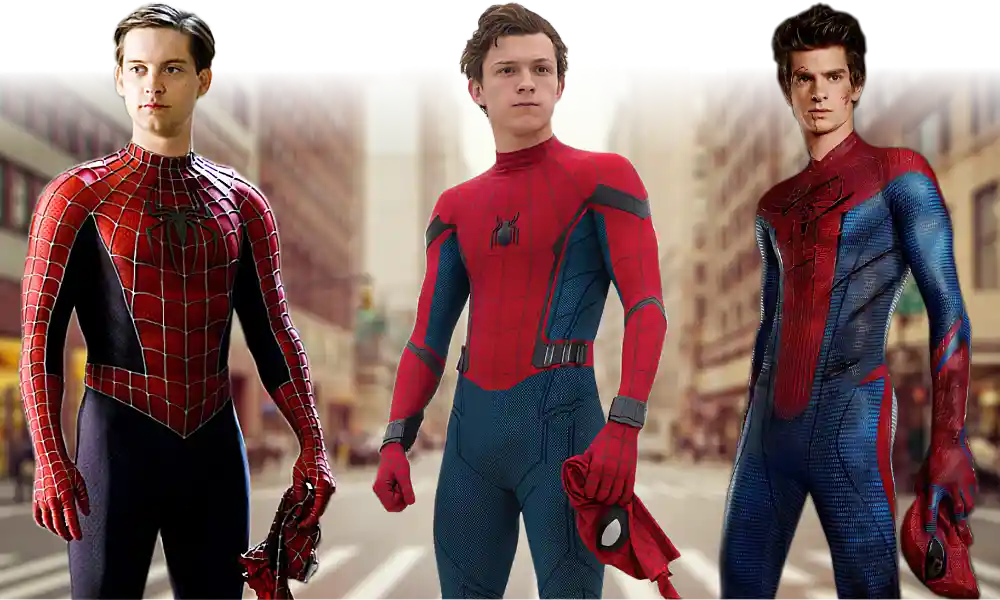Spider-Man has been a popular comic book superhero since he first appeared in Amazing Fantasy #15 in 1962. Created by Stan Lee and Steve Ditko, Spidey has been web swinging through comic books, cartoons, television shows, movies, video games, amusement parks, and even on Broadway. This post attempts to catalog Spidey’s first fifty-plus years on the big screen, including behind the scene struggles to produce films, his imprisonment within Sony Pictures, and what the future holds for our friendly cinematic Spider-Man.
Fan Films and Small Screens
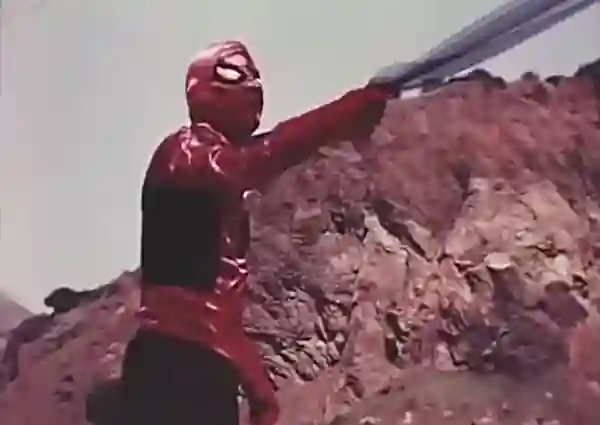
Spider-Man’s cinematic premiere was in the 1969 fan-film Spider-Man, featuring special visual effects, miniatures, explosions, and stunts performed by a Spider-Man blow-up doll. The climax (at about the ten minute mark) features Spidey swinging after the villainous Dr. Lightning (played by Doctor Doom in a t-shirt) as he attempts to make his escape in a red muscle car. The film was made by amateur filmmaker Donald F. Glut, who also starred as Spidey and had previously created several other superhero-related fan films. He would later go on to write for the classic ’80s Spider-Man and His Amazing Friends cartoon show. Glut’s Spider-Man film was actually screened in a theater at the University of Southern California, truly making it the first Spider-Man film shown in a cinema.
Prior to Glut’s fan film, Spider-Man’s first appearance on the small screen was in the 1967 television cartoon Spider-Man. An extremely low-budget series with heavily re-used stock footage, it spawned the “Spider-Man, Spider-Man, does whatever a spider can” theme song.
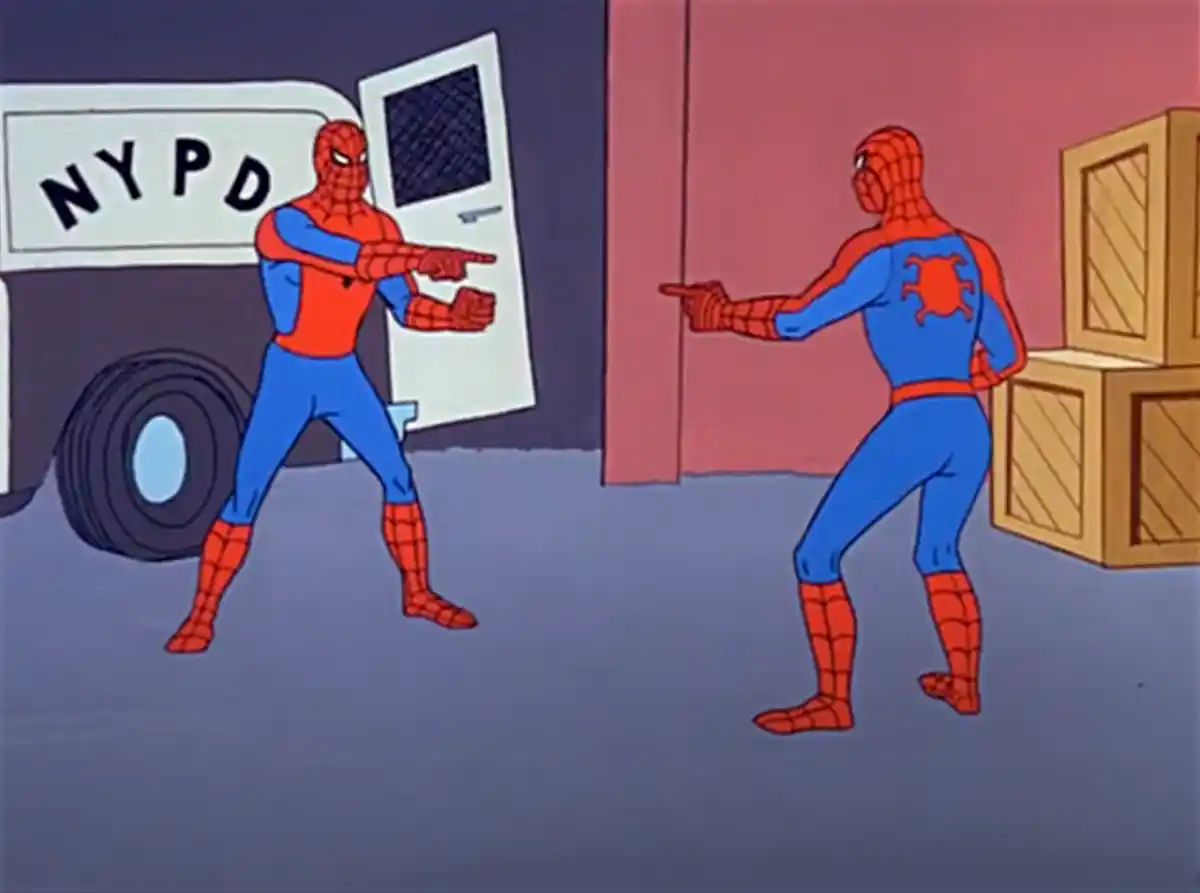 The catchy song has found its way into pop culture, from The Simpsons parody of “Spider-Pig” to a cover by punk rock band the Ramones. Andrew Garfield’s Peter Parker used it as his cell phone ringtone in The Amazing Spider-Man 2, Your Friendly Neighborhood Spider-Man used a sample in the opening credits, and an orchestral version is played over the Marvel Studios title card in Spider-Man: Homecoming. The cartoon was also the origin of the “pointing meme” from the episode “Double Identity” which has been parodied in the Spider-Verse films, Spider-Man: No Way Home, and even Marvel’s Spider-Man 2 video game. For these reasons this campy, cheap cartoon is well worth mentioning as an influential piece of Spider-Man cinematic history.
The catchy song has found its way into pop culture, from The Simpsons parody of “Spider-Pig” to a cover by punk rock band the Ramones. Andrew Garfield’s Peter Parker used it as his cell phone ringtone in The Amazing Spider-Man 2, Your Friendly Neighborhood Spider-Man used a sample in the opening credits, and an orchestral version is played over the Marvel Studios title card in Spider-Man: Homecoming. The cartoon was also the origin of the “pointing meme” from the episode “Double Identity” which has been parodied in the Spider-Verse films, Spider-Man: No Way Home, and even Marvel’s Spider-Man 2 video game. For these reasons this campy, cheap cartoon is well worth mentioning as an influential piece of Spider-Man cinematic history.
The first licensed live-action Spider-Man was the 1977 CBS TV movie Spider-Man, starring Nicholas Hammond as Peter Parker/Spider-Man battling mind-controlled bad guys. After the TV movie aired, the show ran for thirteen episodes with impressive (for the time) wire work that gave Spidey his ability to wall crawl. The series also featured cheesy dialogue, a disco soundtrack, and bell-bottoms. The first season was renamed “The Amazing Spider-Man” but was later renamed back to “Spider-Man” for the second and final season. Three theatrical releases were eventually produced for distribution only in Europe by editing together multiple episodes of the show.
Also in the late ’70s, Toei Company, a Japanese production company, released their own Spider-Man television show—スパイダーマン. While Spider-Man has all of his normal abilities—shooting webs, climbing on walls, Spider-Sense, and the classic red-and-blue costume—his extraterrestrial origin and the enemies he faces are entirely unique to Japan.
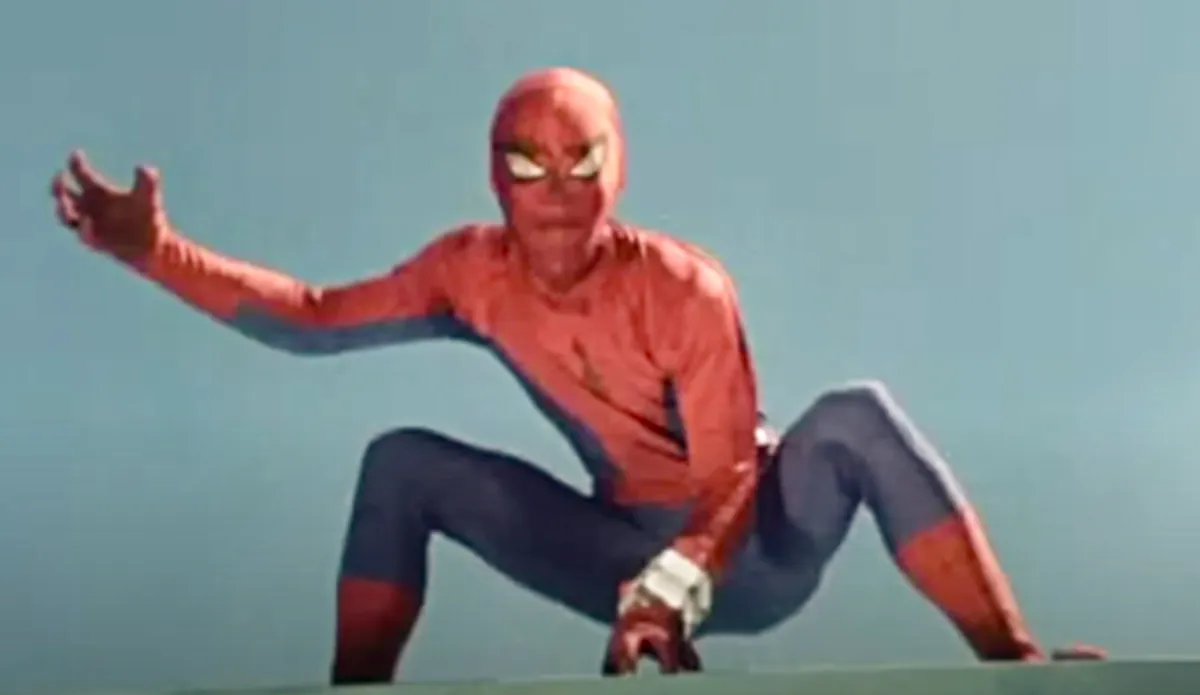 In the forty-episode series, Takuya Yamashiro uses a large wrist device to transform into Spider-Man to fight a monster-of-the-week type villain. Near the end of the fight the monster grows into a giant version of itself, at which point Spider-Man calls down his spaceship that transforms into a giant robot with a sword, and he defeats the monster in a huge explosion. This was a very different Spider-Man created for kids and designed to sell toys in Japan, with Spider-Man’s robots and cars created out of necessity as a way to finance the show. If all of this is beginning to sound mighty familiar to you, this is probably because Spider-Man’s success in Japan heavily influenced the Toei-produced Super Sentai series, better known in the West as Mighty Morphin’ Power Rangers.
In the forty-episode series, Takuya Yamashiro uses a large wrist device to transform into Spider-Man to fight a monster-of-the-week type villain. Near the end of the fight the monster grows into a giant version of itself, at which point Spider-Man calls down his spaceship that transforms into a giant robot with a sword, and he defeats the monster in a huge explosion. This was a very different Spider-Man created for kids and designed to sell toys in Japan, with Spider-Man’s robots and cars created out of necessity as a way to finance the show. If all of this is beginning to sound mighty familiar to you, this is probably because Spider-Man’s success in Japan heavily influenced the Toei-produced Super Sentai series, better known in the West as Mighty Morphin’ Power Rangers.
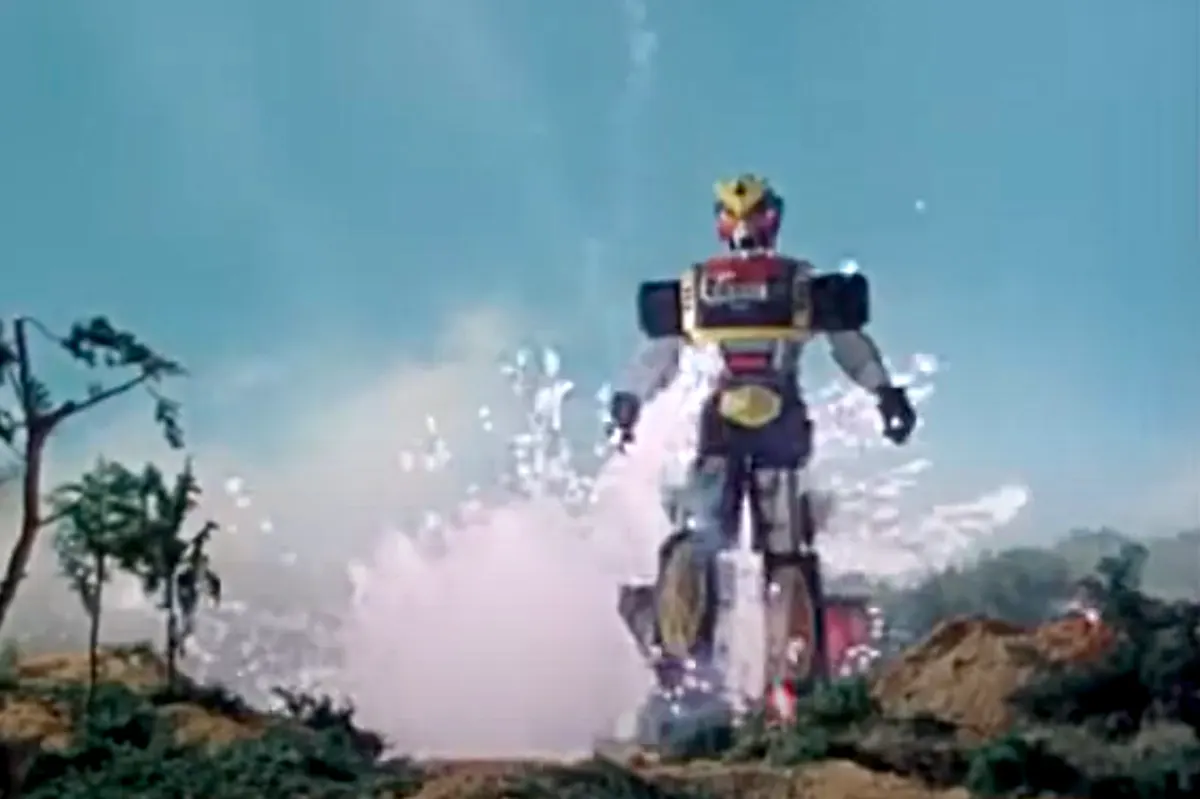
When Toei began work on Spider-Man, they put the current Super Sentai series on hiatus for a year. When production resumed, the Battle Fever J team introduced giant mechas to the franchise, a staple of Super Sentai to this day. And later, Spider-Man’s transforming robot, Leopardon, would also heavily influence the creation of the Marvel comic book The Transformers (in which Spidey briefly battles Megatron). Stan Lee praised Japan’s Spider-Man TV series for the action and special effects, noting that Japan’s culture necessitated different approaches to the traditional Marvel character.
Additionally, a spinoff film of Toei’s Spider-Man was released in theaters in Japan in 1978, introducing a new character to the weekly series.
A Few Bankruptcies and Lawsuits Later…
Back in America in the mid-’80s, Marvel sold the Spider-Man film rights to producer Menahem Golan and his company Cannon Films. Stan Lee vetoed the “Peter Parker transforms into a giant, hairy, eight-armed tarantula and is locked in a basement after refusing to join a mutant master-race” concept at Cannon. Later, a new script was written and the film was given a $20 million budget, however due to the failures of Superman IV and Masters of the Universe, Cannon slashed the budget to just $7 million, losing their director in the process. Cannon later bailed on the whole idea of a superhero movie and later went bankrupt.
After Cannon Films closed, Golan retained the rights to Spider-Man and formed 21st Century Film Corp (not to be confused with 21st Century Fox or 20th Century Studios). He tried to revive the film as a big budget production again, but needed funding, so he pre-sold the theatrical, television, and home video rights to three different companies—the latter going to Sony Pictures. (Although the films are released under the Columbia Pictures banner, both Columbia and the Spider-Man film rights are owned by parent company Sony Pictures.)
Several scripts of a potential Spider-Man film were written for Golan, including a profanity-filled draft by James Cameron with Leonardo DiCaprio as Peter Parker and Arnold Schwarzenegger as Doc Ock, and a sex scene between Spider-Man and MJ on top of the Brooklyn Bridge. Cameron was ready to make the film but several bankruptcies by film studios followed by lawsuits from more film studios resulted in a Spider-Man filmmaking limbo for several years. (Variety attempted to unravel the mess back in 1998.)
In 1995, a judge ruled that the film rights had reverted to Marvel, with the exception of the home video rights, which Sony Pictures retained. By this time, however, the entire comic book industry was struggling. Marvel’s financial woes were worsened by several poor investments made by then-CEO Ronald Perelman, ultimately leading the company to file for bankruptcy. Following the bankruptcy, ToyBiz owners Ike Perlmutter and Avi Arad took control of Marvel, with Arad founding Marvel Films, which was later renamed Marvel Studios.
Emerging from bankruptcy is expensive, so to pay off their debts, Marvel sold the film rights to their most popular characters for whatever amount of cash they could get in the late ’90s. As Sony Pictures still had the home video rights for Spider-Man, Marvel wasn’t able to sell the film rights to anyone else, so they offered Sony Pictures nearly the entire catalog of Marvel characters (with the exception of the X-Men) for $25 million. Sony Pictures had the entire future MCU on the table, but they passed, telling Marvel “audiences only care about Spider-Man.” In the end, Sony Pictures picked up the film rights to Spidey in 1999 for a mere $7 million, which is where Spider-Man remains jailed in perpetuity.
Tobey Suits Up
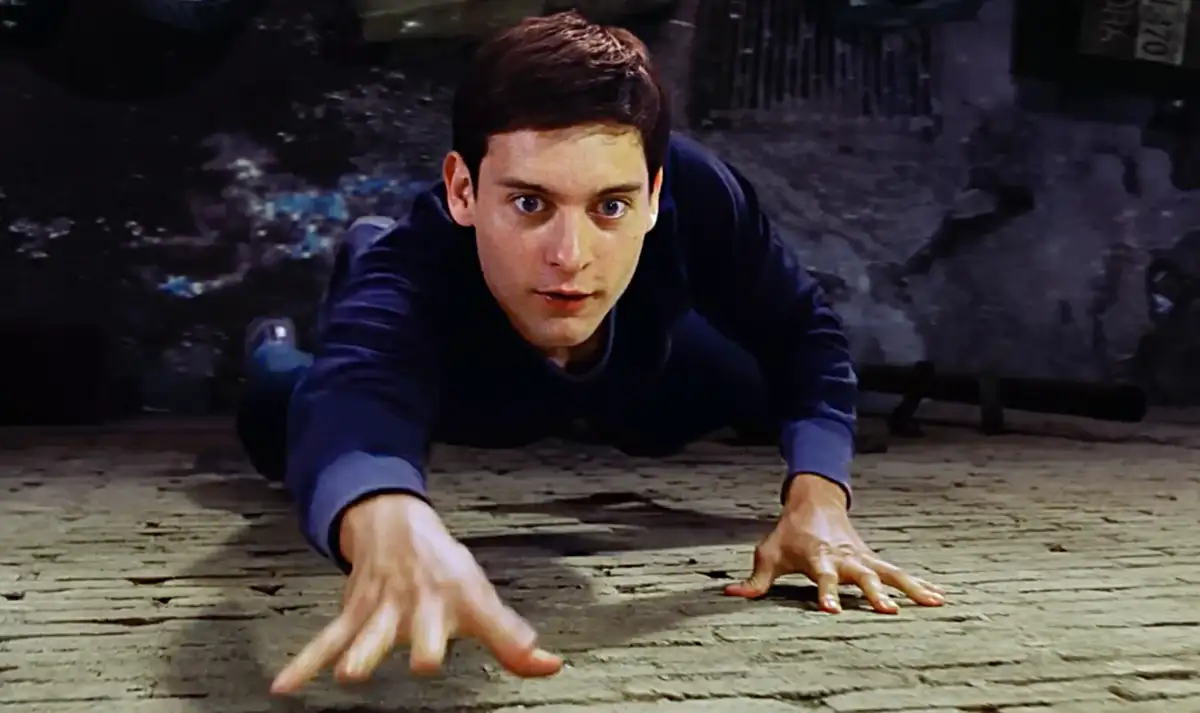
Starring Tobey Maguire and directed by Sam Raimi, 2002’s Spider-Man is the web-slinger’s classic origin story played out in full as Peter Parker is bitten by a radioactive spider, gains spider-like abilities, watches Uncle Ben die, kisses Mary Jane Watson (Kirsten Dunst) while hanging upside down, battles the Green Goblin (Willem Dafoe), saves New York City, and shoots webbing out of slits in his wrists. The wrists idea was from the original James Cameron script, and Raimi liked it, fearing Peter Parker inventing his own web-shooters would stretch the audience’s suspension of disbelief too far. Despite the controversial web-shooter change, the film was a huge hit, spawning two sequels and reviving the superhero genre with audiences and critics alike.
Spider-Man made history as the first movie to break $100 million at the box office in its opening weekend. By the end of its theatrical run, it had pulled in $825 million worldwide. But beyond the box office numbers, it redefined what a summer blockbuster could be and set the new standard for superhero movies.
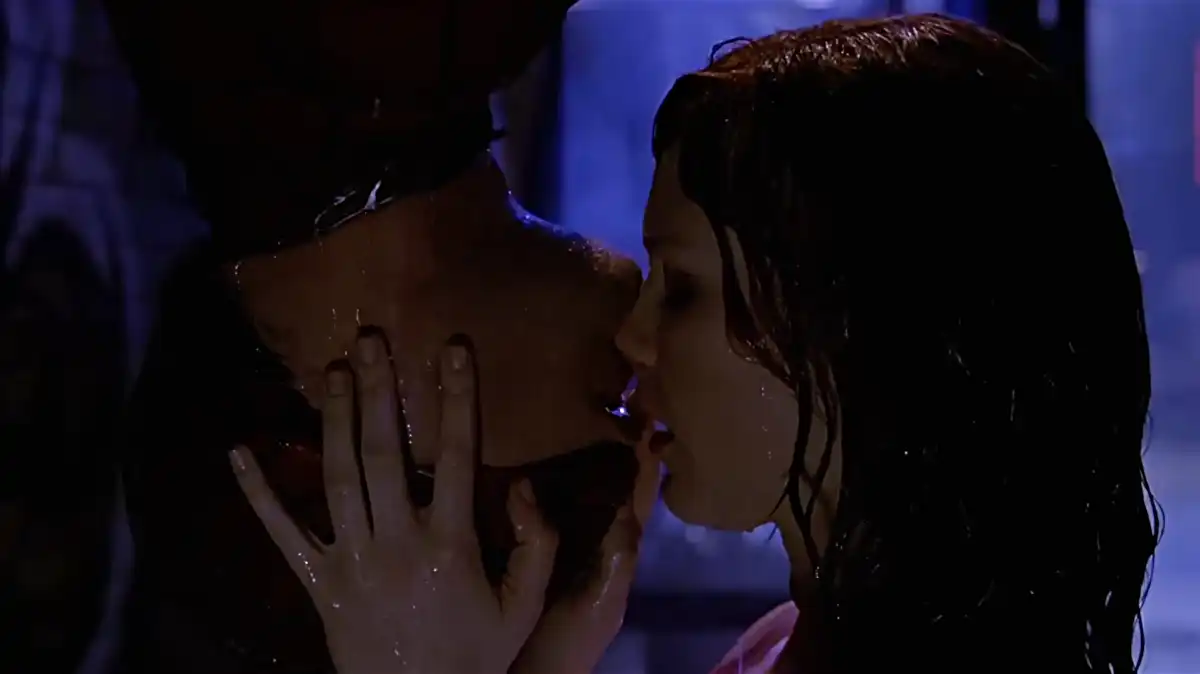 Sam Raimi’s Spider-Man proved that audiences would show up for a superhero movie packed with action, humor, and romance. Raimi focused on Peter Parker’s humanity and teenage struggles, making him relatable while still delivering exciting comic book action. The film’s groundbreaking visual effects brought Spidey’s web-swinging to life and set the bar for summer blockbusters. This winning formula paved the way for superhero films for years to come, including Marvel’s own Iron Man, which kickstarted the MCU in 2008.
Sam Raimi’s Spider-Man proved that audiences would show up for a superhero movie packed with action, humor, and romance. Raimi focused on Peter Parker’s humanity and teenage struggles, making him relatable while still delivering exciting comic book action. The film’s groundbreaking visual effects brought Spidey’s web-swinging to life and set the bar for summer blockbusters. This winning formula paved the way for superhero films for years to come, including Marvel’s own Iron Man, which kickstarted the MCU in 2008.
The original teaser trailer for the film shows a helicopter trapped in a giant spider web strung between the World Trade Center towers, and the original theatrical poster has the towers reflected in the eyes of Spider-Man’s mask. Both the trailer and poster were pulled after the 9/11 attacks.
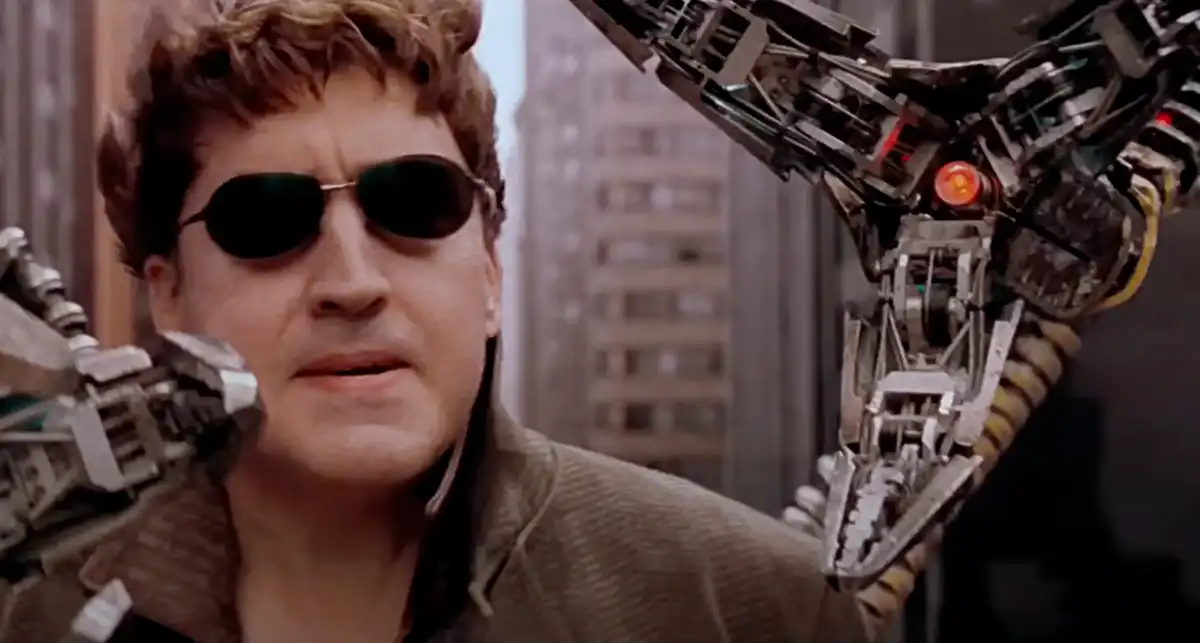
The 2004 sequel Spider-Man 2 featured Alfred Molina as Doctor Octopus and focused on Peter Parker’s desire to be “Spider-Man No More!” (a plot thread largely influenced by Amazing Spider-Man #50). The film was made so long ago that it was cheaper to use practical tentacles for many of the shots of Doc Ock instead of computer visual effects. This movie was another huge hit, both financially and critically, with the film often cited as one of the greatest superhero films ever made. At the 77th Academy Awards, it won the Oscar for Best Visual Effects.
Then, in 2007, Spider-Man 3 somehow happened. In the film, Spidey takes on Sandman, the Green Goblin, and Venom while becoming “Emo Peter Parker,” a thoroughly unlikable character. Overall the film was a poorly developed mess, with too many characters and an unfocused, meandering plot.
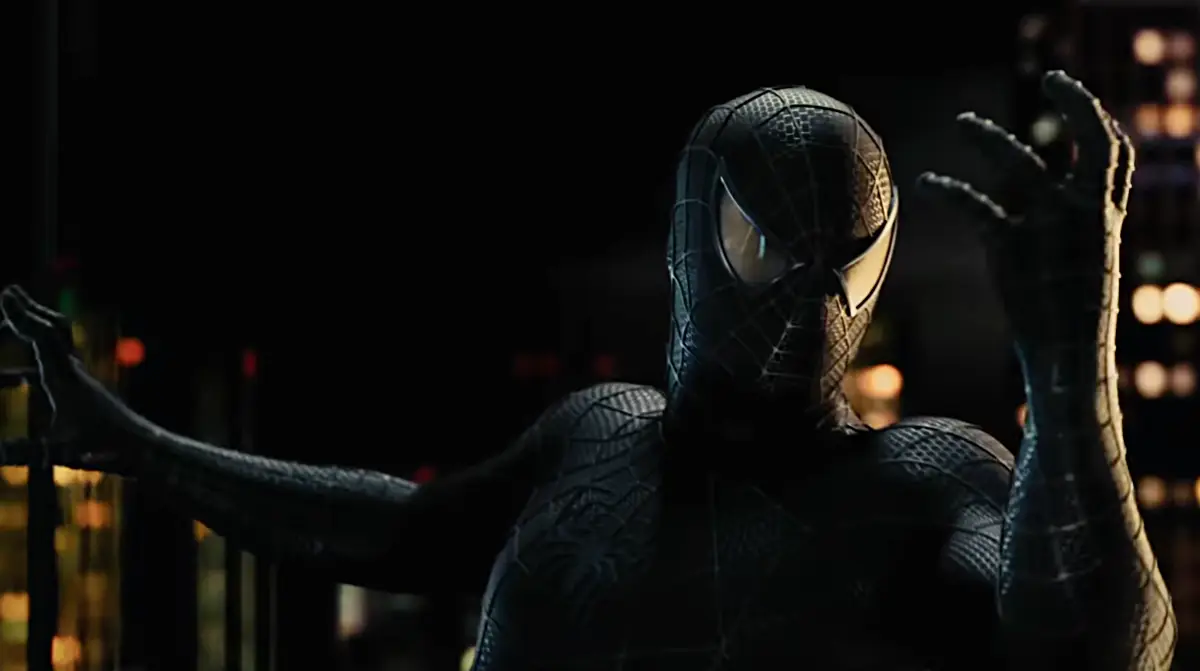 In 2014, Raimi admitted the film was “awful” and Marvel Studios CEO Avi Arad said, “I think we learned that Venom is not a sideshow,” while accepting responsibility for disappointing the fans. Despite earning $891 million at the box office (the highest grossing Spidey film yet) Sam Raimi’s reign on theatrical Spider-Man films would soon end. Spider-Man 4 would have introduced the Black Cat and the Vulture, but overwhelmed by the pressures of a growing budget and larger cast, Raimi called producer Amy Pascal and quit. A Venom spin-off and a 5th and 6th movie in the early stages of production were also cancelled.
In 2014, Raimi admitted the film was “awful” and Marvel Studios CEO Avi Arad said, “I think we learned that Venom is not a sideshow,” while accepting responsibility for disappointing the fans. Despite earning $891 million at the box office (the highest grossing Spidey film yet) Sam Raimi’s reign on theatrical Spider-Man films would soon end. Spider-Man 4 would have introduced the Black Cat and the Vulture, but overwhelmed by the pressures of a growing budget and larger cast, Raimi called producer Amy Pascal and quit. A Venom spin-off and a 5th and 6th movie in the early stages of production were also cancelled.
The Andrew Garfield Reboot
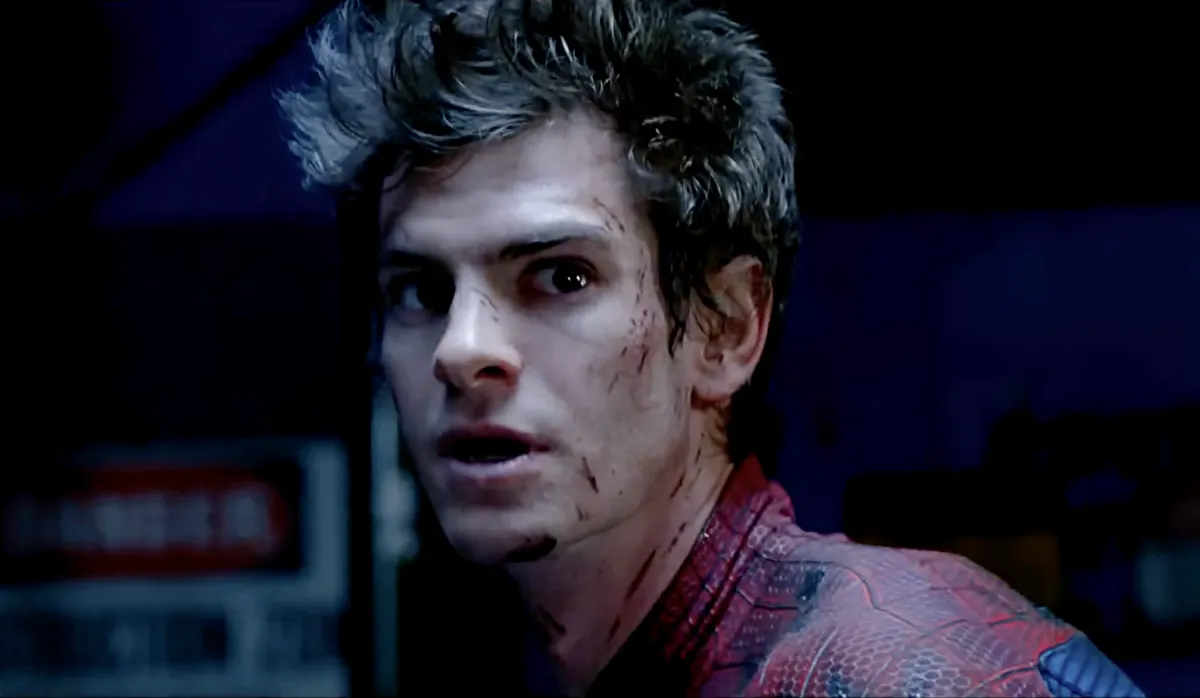
Five years later, The Amazing Spider-Man rebooted the franchise in 2012. Directed by Marc Webb and starring Andrew Garfield as the wall crawler, this Peter Parker designed his own artificial web-shooters, dated Gwen Stacy (future Academy Award winner Emma Stone), and stopped Dr. Curt Conners/the Lizard (Rhys Ifans) from turning everyone in New York into lizard hybrids. Despite retreading the same origin story audiences saw just a decade earlier, it’s a modest success in the Spider-Man franchise, but the lowest-grossing Spider-Man film to date, earning $758 million worldwide. The film’s downward trend at the box office and mixed reviews from critics will continue under the leadership of Sony Pictures and producer Amy Pascal. Despite the lower than anticipated box office results for the reboot, you can bet your web-shooters that Sony Pictures made a sequel.
The Amazing Spider-Man 2 forced audiences to sit through 141 minutes of contrived teen relationship drama in a superhero movie.
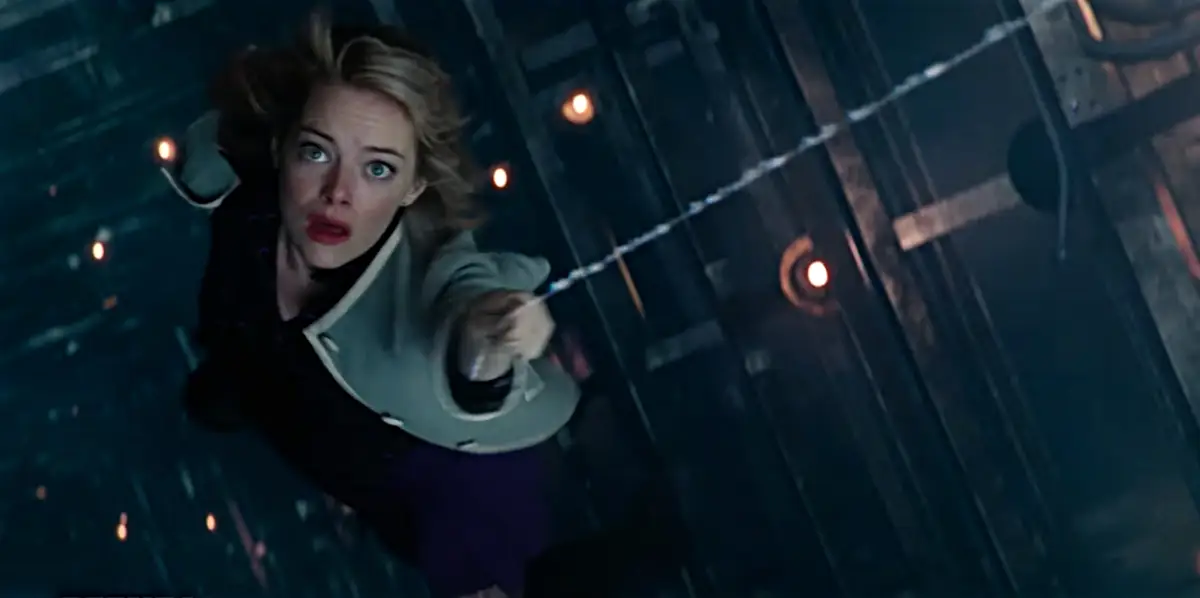 Electro (Jamie Foxx) and the Green Goblin (Dane DeHaan) are Spidey’s foes this time around, while Black Cat and the Rhino make some blink-and-you’ll-miss-them cameos. And if the relationship had been slightly more compelling, perhaps the audience would have felt something at the death of Gwen Stacy at the end of the film. More backstory is revealed about the disappearance of Peter’s parents, but before all the mysteries are revealed the film is over and the bad reviews are out.
Electro (Jamie Foxx) and the Green Goblin (Dane DeHaan) are Spidey’s foes this time around, while Black Cat and the Rhino make some blink-and-you’ll-miss-them cameos. And if the relationship had been slightly more compelling, perhaps the audience would have felt something at the death of Gwen Stacy at the end of the film. More backstory is revealed about the disappearance of Peter’s parents, but before all the mysteries are revealed the film is over and the bad reviews are out.
Disney Buys Marvel
We need to go back a few years, between Raimi’s Spider-Man 3 and Webb’s Amazing Spider-Man, to when Disney bought Marvel for $4 billion.
In 2009, many CEOs did not see the value in Marvel that Disney CEO Bob Iger did. In his memoir, The Ride of a Lifetime,
 Iger explains, “We knew there was a depth to the Marvel universe that most people weren’t aware of.” He was especially impressed with the long-term vision Marvel Studios had developed for the MCU, explaining, “a plan for intertwining characters across multiple films well into the next decade, seemed brilliant to me.”
Iger explains, “We knew there was a depth to the Marvel universe that most people weren’t aware of.” He was especially impressed with the long-term vision Marvel Studios had developed for the MCU, explaining, “a plan for intertwining characters across multiple films well into the next decade, seemed brilliant to me.”
Marvel’s CEO at the time, Ike Perlmutter, “was a mystery to us,” Iger writes. “Ike was a legendarily tough, reclusive character, former Israeli military, who never appeared in public or allowed pictures of himself to be taken.” It took months for Iger to set a meeting; after a few dinners together, Perlmutter explained he wasn’t against the sale, but still had some reservations.
Iger and Apple CEO Steve Jobs had developed a close friendship during Disney’s acquisition of Pixar, which Jobs at the time owned. Iger sought Jobs’ opinion on buying Marvel, but Jobs didn’t care for comic books or superhero movies. Instead, he asked Iger, “Is this one important to you? Is it another Pixar?” Iger wasn’t sure, but he recognized the value Marvel’s brand and characters could bring to Disney. He asked Jobs to vouch for him with Marvel’s reclusive CEO, and Jobs agreed to make a call. Iger writes, “Later, after we closed the deal, Ike told me that he’d still had his doubts and the call from Steve made a big difference to him. ‘He said you were true to your word.’”
Prior to Disney, Marvel struggled on the path to their cinematic universe. Marvel’s first big screen flick, Howard the Duck, bombed in 1986. A low-budget Captain America, filmed in Yugoslavia, did worse a few years later. And the very first Fantastic Four movie was so bad it was never released but survives on low quality YouTube bootlegs. It wasn’t until New Line Cinema’s Blade, starring Wesley Snipes, and Fox’s X-Men in 2000, that Marvel saw its first glimmers of success, although neither of these were the billion dollar superhero blockbusters of today.
Inside Marvel, however, there were new attempts at self-producing their own films. Over the next decade, the rights to various characters, like Iron Man and Hulk, found their way back to Marvel. Meanwhile, the future mastermind of the MCU, Kevin Feige, began his career as a production assistant on the films Volcano and You’ve Got Mail, later becoming an associate producer on Fox’s X-Men for his deep knowledge of Marvel comics. He soon joined Marvel Studios as a producer on the Spider-Man, X-Men, and Fantastic Four films of the early 2000’s. Amy Pascal recalled Feige’s early days as a producer, describing him as someone who attended all of the meetings, was humble, and made a lasting impression with his intelligence and big ideas.
After the success of Iron Man in 2007, Feige was promoted to president of Marvel Studios. His leadership and knowledge of Marvel lore would shape the MCU’s trajectory for years to come.
Sony’s Web Unravels
After The Amazing Spider-Man 2‘s poor box office performance and lackluster reviews, Sony Pictures needed help. This was supposed to be the answer to the Marvel Cinematic Universe and a major launchpad for Sony’s Spider-Man Universe, with Venom, the Sinister Six, Black Cat, and more Garfield-starring Spider-Man films in early stages of production.
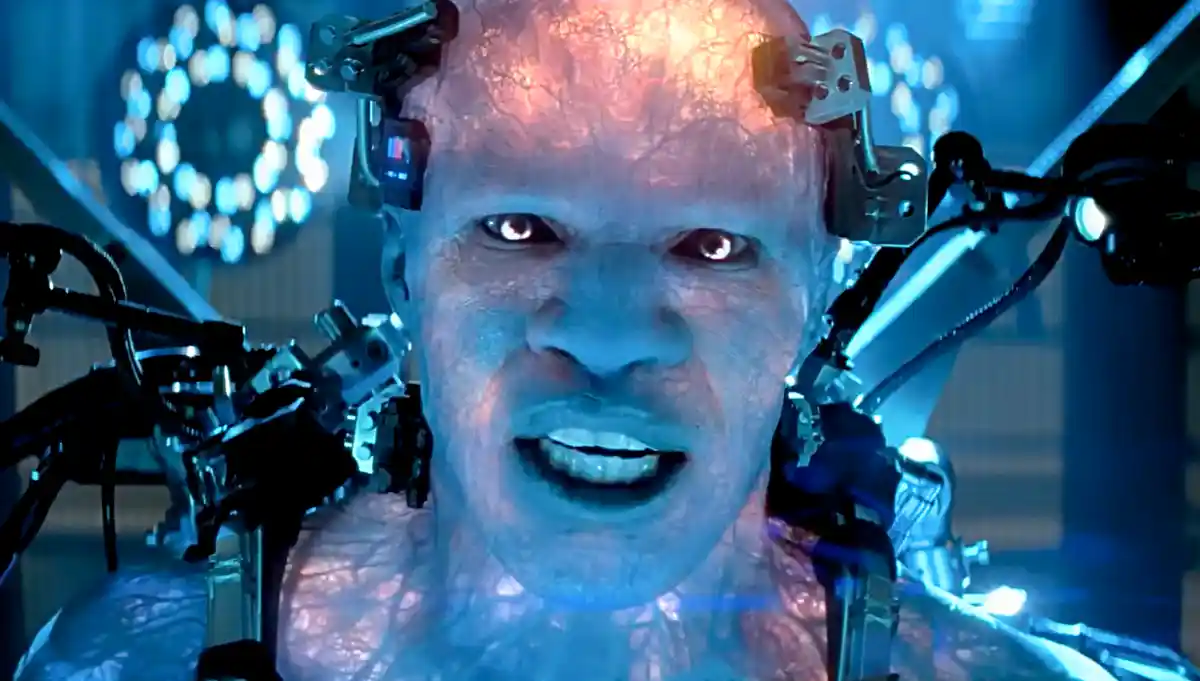
But Pascal suspected her film was a disaster before it was released. In an email to an executive at Sony Pictures (leaked by WikiLeaks), she wrote the film was “uneven, schizo tone … weird, disjointed … not funny … wrong director and wrong casting.” You’ll note Pascal deflecting blame, a theme we’ll see often from Sony Pictures and Pascal, when in fact it was Pascal who ordered the film be stuffed with villains to prep her future Sinister Six spin-off!
Feige also wasn’t a fan of Sony Pictures’ The Amazing Spider-Man films and, while not involved in their development, he did give feedback to Pascal. Feige had issues with Garfield’s performance as Peter, noting “a lot of crying and then a lot of mania,” and the film’s nonsensical “special blood” plotlines, arguing it detracts from “the idea that Peter is normal kid from Queens who becomes the greatest super-hero in the world.” He also strongly disagreed with the decision to reboot the films after Raimi’s departure, saying he would never advocate rebooting the MCU.
In the excellent book MCU: The Reign of Marvel Studios, by Joanna Robinson, Dave Gonzales, and Gavin Edwards, they note that Pascal had ambitions for her own cinematic universe but complained that she was limited to only the Spider-Man characters—slim pickings of just 856 characters. The MCU authors cheekily note that Marvel turned B-list characters into a massively successful cinematic universe, but if my research has taught me anything, it’s that Sony Pictures’ producers aren’t exactly known for accountability or creative problem-solving.
When Pascal realized her Spider-Man franchise was failing, she called Feige and asked for help on producing the next Spider-Man film. Pascal was still thinking about her Spider-Man universe and the possibilities for The Amazing Spider-Man 3 but Feige instead pitched the idea of Tony Stark making Spidey’s suit, ultimately bringing Spider-Man into the sprawling MCU.
Negotiations eventually broke down between Disney and Sony Pictures brass over how the box office cash would be split on a shared Spidey flick, so Pascal went back to toiling in her Spider-Man/Sinister Six films without Feige and Marvel.
 When North Korean hackers leaked over 200,000 emails from Sony Pictures, however, things suddenly changed. News spread that Marvel had pitched bringing Spidey into the MCU, and the fans wanted this more than a third Andrew Garfield romp. (The Sinister Six script had Spidey riding a T-Rex in the Savage Lands, yikes!) The studios tried again, agreeing that profits wouldn’t be split: each studio would simply keep the profits from their own films. The studios finally had a deal, and Sony’s Spider-Man Universe was shelved.
When North Korean hackers leaked over 200,000 emails from Sony Pictures, however, things suddenly changed. News spread that Marvel had pitched bringing Spidey into the MCU, and the fans wanted this more than a third Andrew Garfield romp. (The Sinister Six script had Spidey riding a T-Rex in the Savage Lands, yikes!) The studios tried again, agreeing that profits wouldn’t be split: each studio would simply keep the profits from their own films. The studios finally had a deal, and Sony’s Spider-Man Universe was shelved.
The hack had another odd consequence: Amy Pascal was fired from Sony Pictures after the leaked emails discussing Spidey and the MCU also revealed her making racist jokes about then-President Obama. The New York Times would later give her firing reason as “her movie operation had failed to keep pace with an entertainment industry shift toward franchise films.” Whatever the reasons, little would change as Pascal formed her own production company with her $40 million severance and $9 million annual payments from Sony Pictures to continue producing their films, including Spider-Man.
Spidey Swings into the MCU
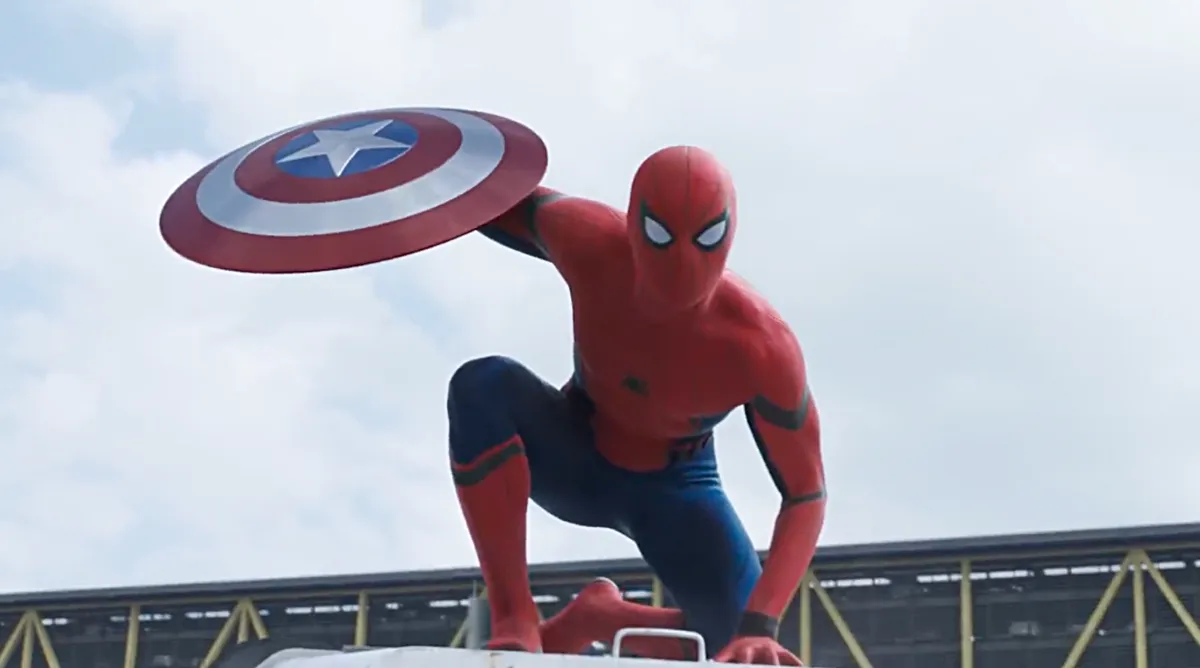
In 2014, eighteen-year-old newcomer Tom Holland was cast as Spider-Man in Captain America: Civil War. Spidey finally joins Iron Man, Captain America, Black Widow, Hawkeye, Ant-Man, Scarlet Witch, Winter Soldier, Falcon, War Machine, Vision, and (also making his MCU debut) Black Panther to battle it out in a German airport. Cap and his team are attempting to escape to Siberia to stop Zemo, but Tony Stark is under orders from the US Government and the newly enacted Sokovia Accords to stop them from leaving. Stark calls in his secret weapon, “Underoos!“ as the battle begins, and Spider-Man leaps into the scene, webbing up Cap’s shield. Peter Parker is young and funny, throwing out classic Spidey quips during the epic airport battle. And the new Stark Suit? It takes the classic red-and-blue and gives it a fresh spin—like the eyes resizing to show emotion, a comic book trick that’s finally made its way to the big screen.
Holland is introduced at almost exactly the half-way mark of Civil War (while wearing a pizza T-shirt) and through a six minute chat with Tony Stark the audience skips the “bitten-by-a-spider” origin story and we’re off to battle. The chemistry between Tom Holland and Chris Evans, Anthony Mackie, and Robert Downey Jr. is proof of the great casting that went into finding Holland for the role. Civil War is another huge success in both the MCU and Spider-Man franchises.
Spider-Man: Homecoming picks up immediately after where Civil War left off, with Peter Parker still euphoric over his fight against 50% of the Avengers. Homecoming, produced by both Pascal and Feige, introduces a few new characters to Peter’s world, including best friend Ned (Jacob Batalon), future love interest Michelle, who goes by her initials MJ (Zendaya), and obnoxious nemesis Flash Thompson (brilliantly played by Tony Revolori).
 Spidey battles the Vulture (Michael Keaton), and Robert Downey Jr. has a $10 million cameo as Iron Man. Also showing up in cameo form is Donald Glover as Aaron Davis, aka The Prowler, aka Miles Morales’ Uncle, but so far, Miles has only shown up in animated form (more on that a little further down). Homecoming showcases Holland’s charismatic performance at being an awkward geek and a wise-cracking superhero. Missing from the Maguire/Garfield films were those moments in the comics when Spider-Man makes a trademark quip (or two, or twelve) during the fight with the villain. The audience also gets much more screen time with Spider-Man in-costume as the origin of his powers have already been explained in Civil War. The MCU seems tired of retreading long, overplayed origin stories at this point—no complaints here!
Spidey battles the Vulture (Michael Keaton), and Robert Downey Jr. has a $10 million cameo as Iron Man. Also showing up in cameo form is Donald Glover as Aaron Davis, aka The Prowler, aka Miles Morales’ Uncle, but so far, Miles has only shown up in animated form (more on that a little further down). Homecoming showcases Holland’s charismatic performance at being an awkward geek and a wise-cracking superhero. Missing from the Maguire/Garfield films were those moments in the comics when Spider-Man makes a trademark quip (or two, or twelve) during the fight with the villain. The audience also gets much more screen time with Spider-Man in-costume as the origin of his powers have already been explained in Civil War. The MCU seems tired of retreading long, overplayed origin stories at this point—no complaints here!
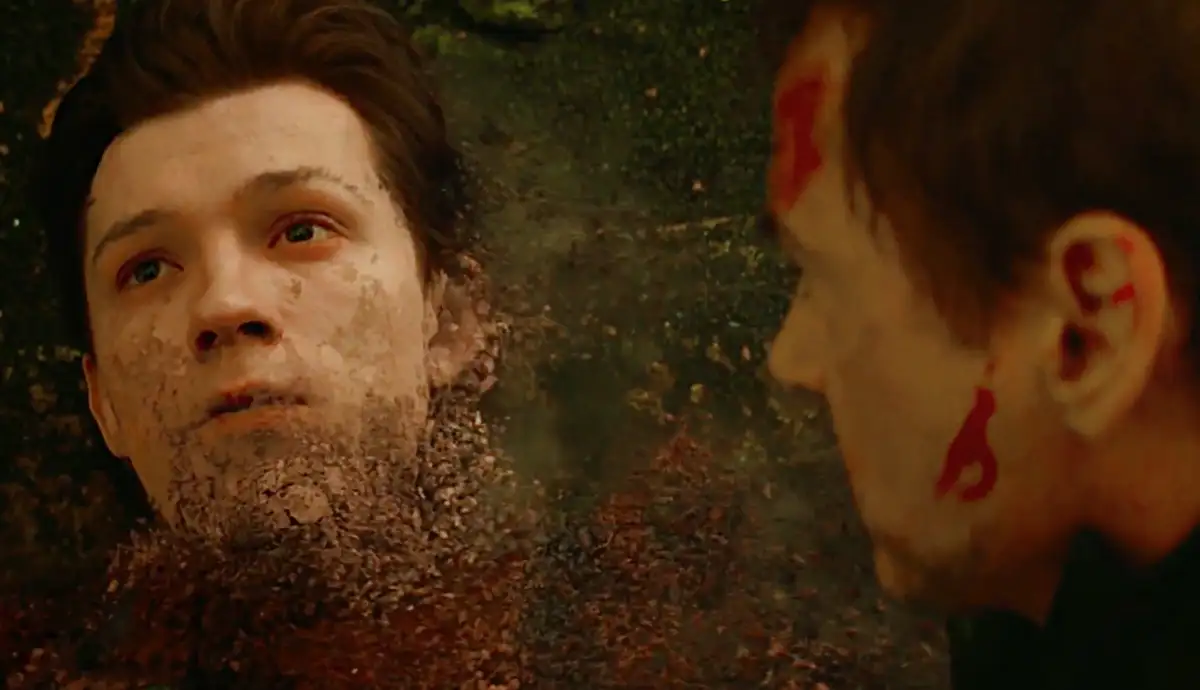
Spider-Man’s next MCU appearance is the massive Avengers: Infinity War spectacle in 2018. In Infinity War, Spidey heads to space with Iron Man and Doctor Strange where he meets up with the Guardians of the Galaxy to battle Thanos. Star Lord goes off-script and Thanos defeats the team in space before heading to Earth to complete his collection of Infinity Stones. With the snap of his fingers, Thanos breaks the heart of every person in the theater as they watch Peter Parker dissolve into dust.
Five years of movie time (and one very long real year) pass before Avengers: Endgame reunites the remaining Avengers as they devise a plan to travel into the past and borrow the Infinity Stones from previous MCU films.
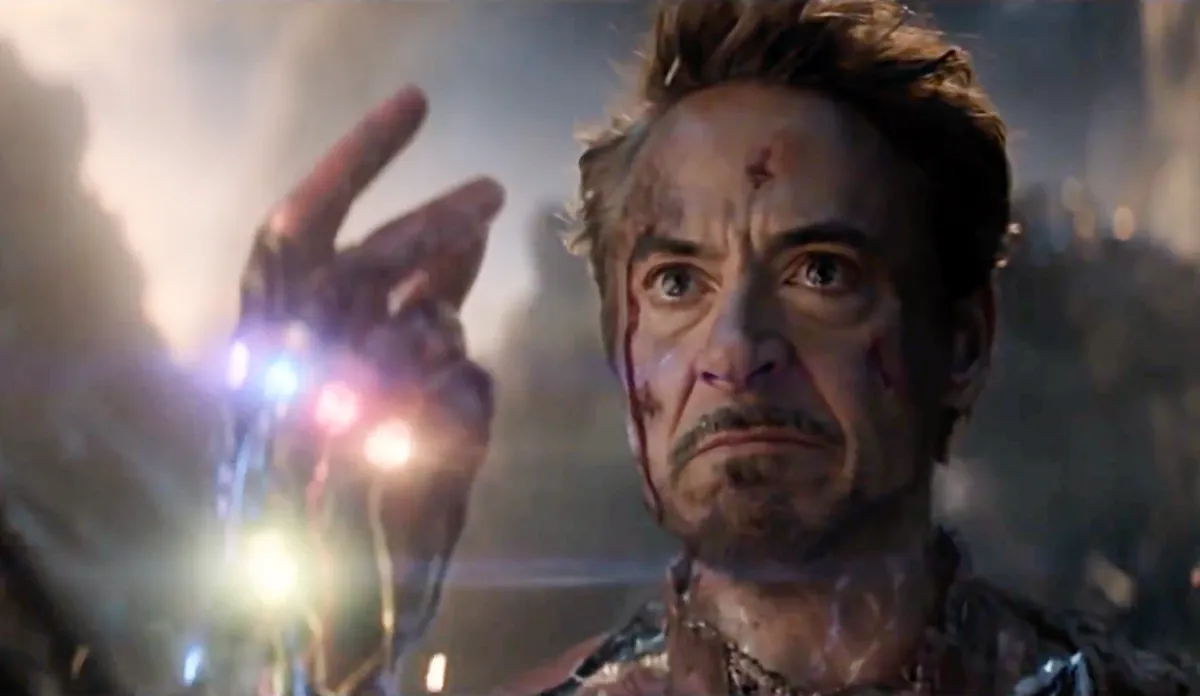 The Avengers snap-back everyone dusted by Thanos, who’s past self shows up to try the whole snapping plan again. Spider-Man joins the Avengers and almost everyone else from every other MCU film as they fight the big purple guy once more and his massive army of Chitauri. Tony Stark sacrifices himself to save the world, proclaiming once again that he is Iron Man. The Earth’s Mightiest Heroes hold a funeral for their fallen friend.
The Avengers snap-back everyone dusted by Thanos, who’s past self shows up to try the whole snapping plan again. Spider-Man joins the Avengers and almost everyone else from every other MCU film as they fight the big purple guy once more and his massive army of Chitauri. Tony Stark sacrifices himself to save the world, proclaiming once again that he is Iron Man. The Earth’s Mightiest Heroes hold a funeral for their fallen friend.
Spider-Man: Far from Home again picks up just days after the events of Endgame and only two months after the film’s release, coining the disappearance and reappearance of those affected by Thanos’s snap as “the blip.” Conveniently, all of Peter’s classmates are blipped, so they all return for the sequel. The class takes a field trip to Europe, where Spider-Man meets Nick Fury and Maria Hill (sort of, they’re actually Skrulls in disguise), and encounters new BFF Quentin Beck/new arch-nemesis Mysterio.
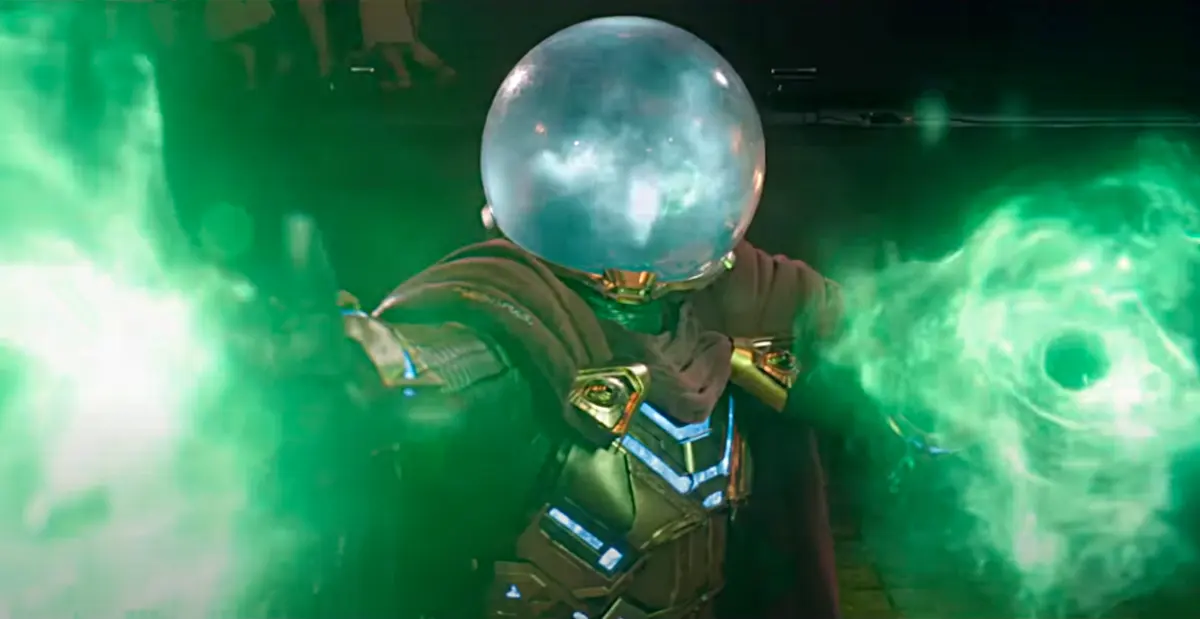 Spider-Man is given special Tony Stark designed spectacles, called E.D.I.T.H., that can summon killer drones and hack smartphones. Peter also self-designs a new red and black suit in a homage to the original Iron Man suit design montage, complete with “Back in Black” soundtrack. (Happy gets the reference.) By the end of the film, Peter’s secret identity is known by the entire world as J. Jonah Jameson (J. K. Simmons, reprising his role from the Raimi films) shares Beck’s final words with all of New York: “Spider-Man’s name is Peter Parker!”
Spider-Man is given special Tony Stark designed spectacles, called E.D.I.T.H., that can summon killer drones and hack smartphones. Peter also self-designs a new red and black suit in a homage to the original Iron Man suit design montage, complete with “Back in Black” soundtrack. (Happy gets the reference.) By the end of the film, Peter’s secret identity is known by the entire world as J. Jonah Jameson (J. K. Simmons, reprising his role from the Raimi films) shares Beck’s final words with all of New York: “Spider-Man’s name is Peter Parker!”
It's well worth mentioning here that Endgame and Far From Home both earned over $1 billion at the box office in 2019—setting a new record for a Spider-Man film. This success cemented Marvel Studios president Kevin Feige as one of the most successful film producers in the world. However, under their original agreement, Disney earned nothing from Far From Home. They proposed a new deal with a 50-50 split on production and box office for future Spidey films, later lowering the offer to 25%, but Sony didn’t bite.
Shortly after Far from Home crossed the billion dollar box office mark, negotiations broke down between the studios.
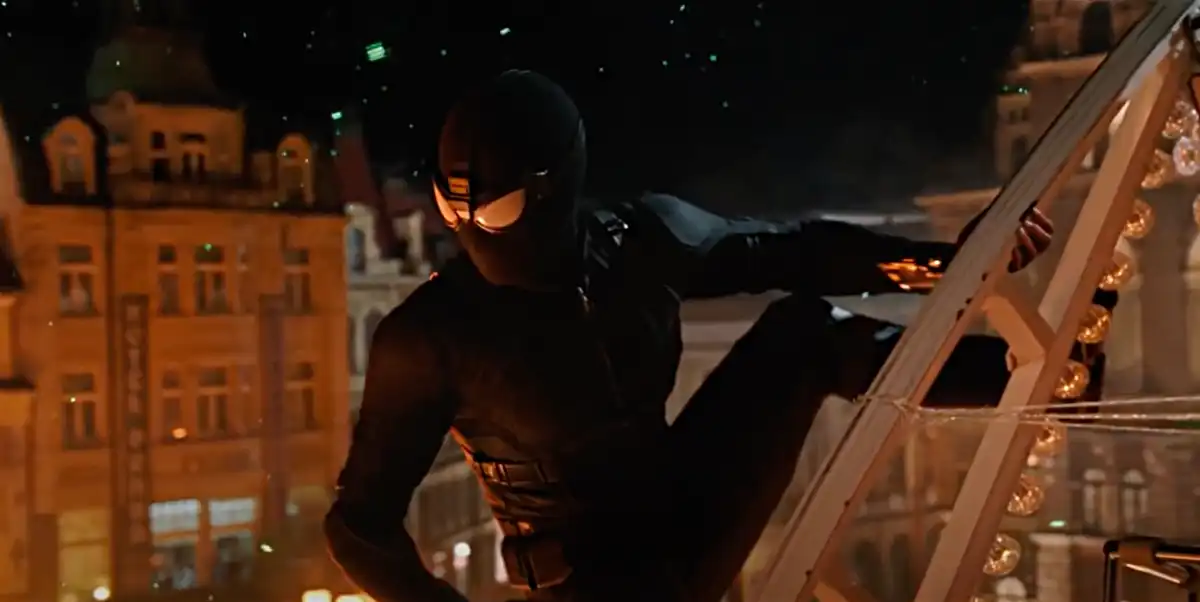 Spidey would exit the MCU, and Sony Pictures would return to independently producing future Spider-Man films, keeping Tom Holland as Spidey. Sony Pictures said they were “disappointed” that Marvel will no longer be a producing partner, but just a few weeks later, and with the encouragement of Holland, Marvel and Sony Pictures announced a new agreement had finally been reached, with Marvel co-producing the next Spider-Man film. Financially, the Walt Disney Company got their reduced 25-25 split – and as Far from Home has proven, 25% of a Spider-Man box office is still a massive payday, even for Disney.
Spidey would exit the MCU, and Sony Pictures would return to independently producing future Spider-Man films, keeping Tom Holland as Spidey. Sony Pictures said they were “disappointed” that Marvel will no longer be a producing partner, but just a few weeks later, and with the encouragement of Holland, Marvel and Sony Pictures announced a new agreement had finally been reached, with Marvel co-producing the next Spider-Man film. Financially, the Walt Disney Company got their reduced 25-25 split – and as Far from Home has proven, 25% of a Spider-Man box office is still a massive payday, even for Disney.
This was an important agreement for Disney to make. With the Avengers Campus lands opening at various Disney Parks over the next couple of years, and the Spider-Man ride specifically swinging into Disney California Adventure in 2021, keeping Spidey in the MCU was a must. The story as Disney CEO Bob Iger tells it is Tom Holland called him on the phone about the deal with Sony Pictures and encouraged him to fix it. Iger called the people at Sony Pictures and he said, “we have to get this done, for Tom and for the fans.” And to both of these massive corporation’s credit, they did.
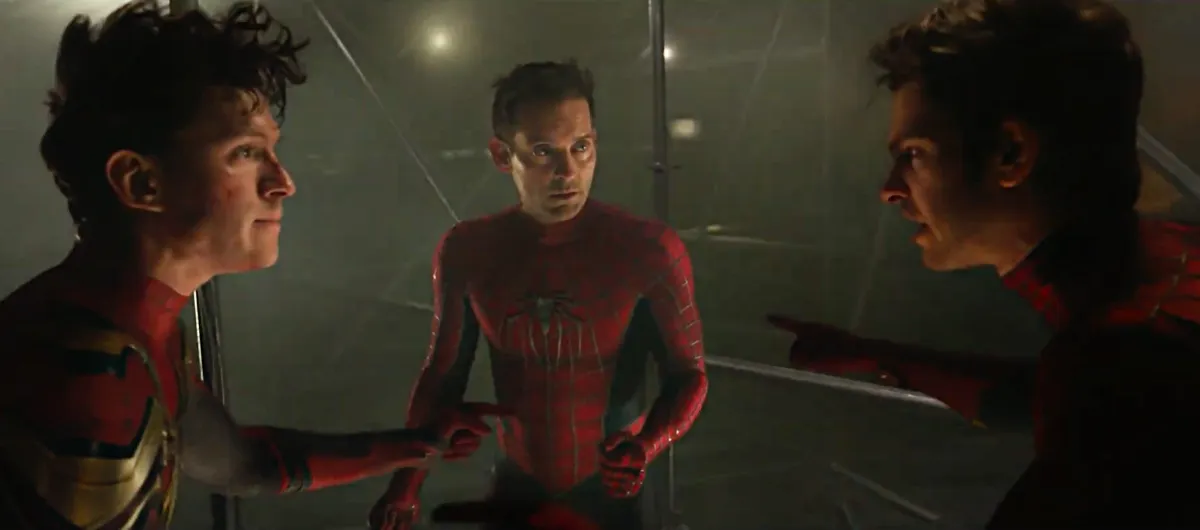
Spider-Man: No Way Home (delayed due to the COVID-19 pandemic) released on December 17th, 2021, co-produced by Marvel and Sony Pictures, with Tom Holland returning for the sixth time as Spidey. Joining him are Zendaya as MJ, Benedict Cumberbatch as Doctor Strange, Jon Favreau as Happy, Jacob Batalon as Ned, Marisa Tomei as Aunt May, Benedict Wong as Wong, Willem Dafoe as the Green Goblin, Alfred Molina as Doctor Octopus, Jamie Foxx as Electro, Rhys Ifans as the Lizard, Thomas Haden Church as Sandman, and with Tobey Maguire and Andrew Garfield returning as their multiverse Spider-Man counterparts from the previous Sony Pictures francises. (In the script, they’re named Raimi-Verse Peter and Webb-Verse Peter, referencing the directors of the previous films.) In the film, Peter Parker attempts to undo his public outing as Spider-Man with the help of “Mr. Strange” but the spell goes awry, tearing open the walls between the multiverse and attracting both friend and foe from universes beyond Peter’s own. The film spends a great deal of time tying up loose threads from the previous Spider-Man franchises and allowing previous heroes and villains to make amends with their past. Working together, the three Spider-Men are able to cure the five villains, but repairing the multiverse causes the entire world to forget Peter Parker, including Ned and MJ. This is also the first time in the MCU a character says the iconic line, “with great power, comes great responsibility.”
Maguire and Garfield didn't sign onto the film until production had paused for the winter holidays. After, Marvel did everything they could to keep their involvement in the film a secret until Garfield was outed by his DoorDash delivery driver. Despite the rumors, Marvel, Garfield, and everyone else involved continued to deny their existence in the film, even releasing altered trailers with the other two Spider-Men removed from the climatic final battle.
Despite the exceptionally deadly rise in the ongoing COVID-19 pandemic, No Way Home became the sixth highest grossing film of all time, earning over $1.9 billion worldwide. It was the highest grossing film of 2021, the highest grossing Spider-Man film, and Sony Pictures’ highest grossing film of all time—quite the return on a seven million dollar purchase in 1999. Critics and audiences praised the film’s actors, direction, and visual effects.
Future Speculation
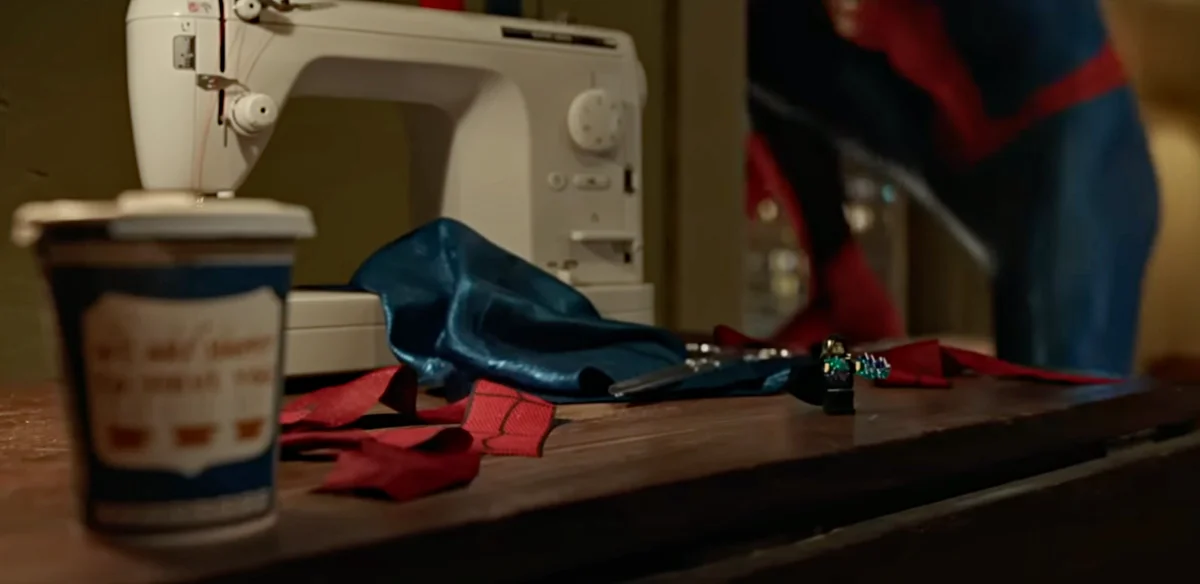
Shortly before No Way Home premiered, Holland stated that playing Spider-Man as a thirty-year-old meant he had “done something wrong” during his career and that No Way Home was the final film in his contract. However, a few weeks later producer Amy Pascal stated that work had begun on a new trilogy of Spider-Man films with Holland, with Marvel’s Kevin Feige promising the partnership between Disney and Sony Pictures would continue through this new trilogy.
In October of 2024, shortly after Tom Holland officially confirmed he’ll return as the wall crawler, Spider-Man 4 received an official release date of July 24th, 2026, just two months after Avengers: Doomsday. Filming is scheduled to begin this summer. Holland also mentioned that he had read an early draft of the script with girlfriend and Spider-Man co-star Zendaya, implying there’s a good chance MJ (and Ned?) will return for the new film.
Updated April 1, 2025: Marvel and Sony have announced Spider-Man: Brand New Day releases in theaters July 31st, 2026, with returning stars Tom Holland, Zendaya, and Jacob Batalon, and Sadie Sink joining the cast in a mysterious new role. Additionally, during Marvel’s Doomsday cast reveal last week, there was no mention of Holland—read into that what you will.
Rumors also suggest we’ll see Holland in a pair of brand new Avengers films, Avengers: Doomsday and Avengers: Secret Wars, scheduled for release in 2026 and 2027, respectively. Robert Downey Jr. will be returning to the MCU, but not as Iron Man—he’ll be Doctor Doom! Could Spidey be teaming up with the Avengers and the soon-to-be introduced Fantastic Four to battle Downey Jr.’s Doctor Doom next summer?
As Marvel and Sony Pictures have often worked in superhero trilogies, it seems likely Spider-Man 5 and Spider-Man 6 are not too far down the road, although they could be the cap on Holland’s young career. In a recent interview with Men’s Health, Holland said, “When I have kids, you will not see me in movies anymore.” His plans apparently involve being a dad and playing golf, “and I will just disappear off the face of the earth.” Sounds like a well-deserved retirement plan, and I think Spidey would approve. You’ll be missed, Tom!
Sony’s Spider-Man Universe
Outside of the MCU, Sony Pictures has been working on their own slate of Spider-related non-MCU films and, despite a conspicuous absence of red and blue spandex, the films do relate to our hero:
Earlier, I quipped that Spider-Man has been jailed at Sony Pictures for nearly thirty years, after Sony Pictures purchased the film rights for all of Spider-Man for just $7 million. I say Spidey is jailed here because, unlike Kate Bishop, Kamala Khan, or Riri Williams, Spider-Man characters are extremely limited in their ability to just pop-up in random MCU films, requiring special permission from Sony Pictures. As the MCU grew to be one of the largest and most successful film franchises in history, Sony Pictures took a long, careful look at their portfolio of Spider-Man characters and drew some names out of Amy Pascal’s hat.
This is a good place to clarify that while Sony’s Spider-Man Universe films are not considered canon in the MCU, Sony Pictures considers the MCU events canon for their films. Confusing? Think of it like this: Sony’s Spider-Man Universe is fan fiction for the MCU, with all the quality and professionalism you’d expect from an internet message board.
Sony Pictures released Venom in 2018, a reboot of the character from the Tobey Maguire Spider-Man days. Venom stars Tom Hardy as Eddie Brock, a reporter down on his luck who breaks into a medical research center and comes into contact with the symbiote, forming a buddy-cop type relationship.
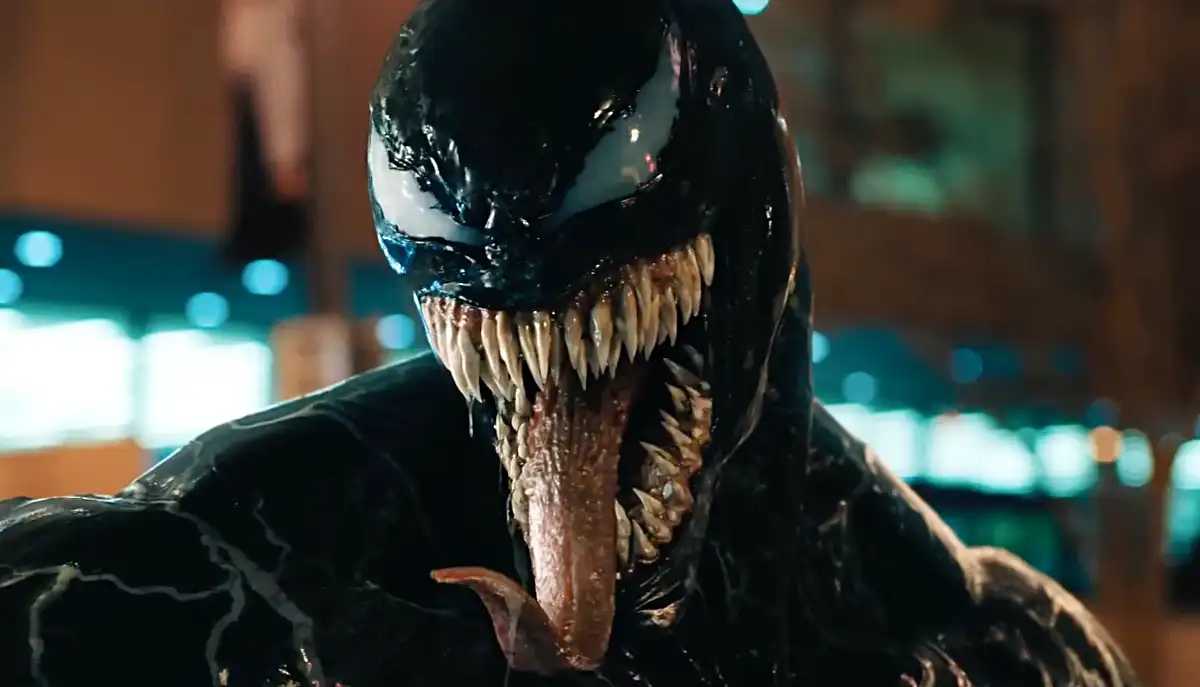 In the comics, the character of Venom is based on Spider-Man’s abilities, but this film version of Venom is not connected to any multiverse Spidey, and his film origin shares nothing with the wall crawler. In the comics, the design of Venom is based heavily on Spider-Man: Venom’s eyes reflect Spider-Man’s mask, Venom’s tendrils mimic Spider-Man’s webs, and his ability to wall crawl and react to danger (Spider-Sense) were learned from Peter Parker as he wore the symbiote. However, Venom as a standalone character without the Spider-Man origin feels hollow and turns Venom into a generic monster movie. Despite the film receiving mostly negative reviews from critics, it made a lot of money at the box office, so Sony Pictures made a sequel.
In the comics, the character of Venom is based on Spider-Man’s abilities, but this film version of Venom is not connected to any multiverse Spidey, and his film origin shares nothing with the wall crawler. In the comics, the design of Venom is based heavily on Spider-Man: Venom’s eyes reflect Spider-Man’s mask, Venom’s tendrils mimic Spider-Man’s webs, and his ability to wall crawl and react to danger (Spider-Sense) were learned from Peter Parker as he wore the symbiote. However, Venom as a standalone character without the Spider-Man origin feels hollow and turns Venom into a generic monster movie. Despite the film receiving mostly negative reviews from critics, it made a lot of money at the box office, so Sony Pictures made a sequel.
Venom: Let There Be Carnage introduced the Carnage symbiote into Sony’s Spider-Man Universe. Serial killer Cletus Kasady (Woody Harrelson) is on death row when he bites Eddie Brock, unknowingly infecting himself with the symbiote. In the comics, Spidey and Venom often team up to defeat Carnage, but the film version of Venom manages to eke out a solo win. By the end of the film, Eddie Brock is a wanted fugitive and leaves the country. In a post-credits scene from Let There Be Carnage, Brock is transported to the Marvel Cinematic Universe, where he sees the news of Peter Parker being outed as Spider-Man. In a post-credit scene from Spider-Man: No Way Home, Brock is finally sent back to his own dimension, but a tiny droplet of the Venom symbiote is left behind in the MCU. Time will tell if Kevin Feige opts to revisit this tiny glob of Venom in future MCU Spidey films. Reviews for Let There Be Carnage were not any better than the first film, but again the film made money, so Sony Pictures made another.
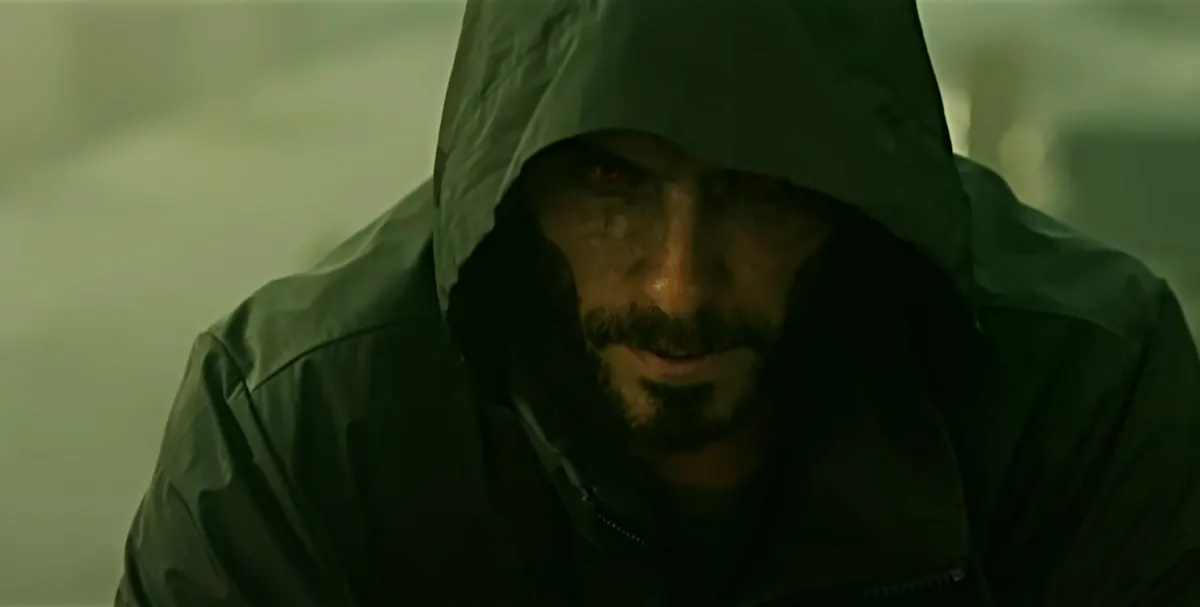
Morbius was Sony Pictures’ next attempt at expanding their Spider-Man-less Universe but failed miserably at the box office. Released on April 1, 2022, the only ones being fooled were people buying tickets to Morbius. The terrible film was ridiculed mercilessly by online memes, which caused its popularity to soar. Sony Pictures, embracing the motto “there’s no such thing as bad publicity” quickly re-released the film to theaters on June 3, only for it to bomb again. Twice bitten…
Sony Pictures, apparently thinking they couldn’t do worse than Morbius, released Madame Web in 2024, to which Madame Web replied, “Hold my web shooter,”
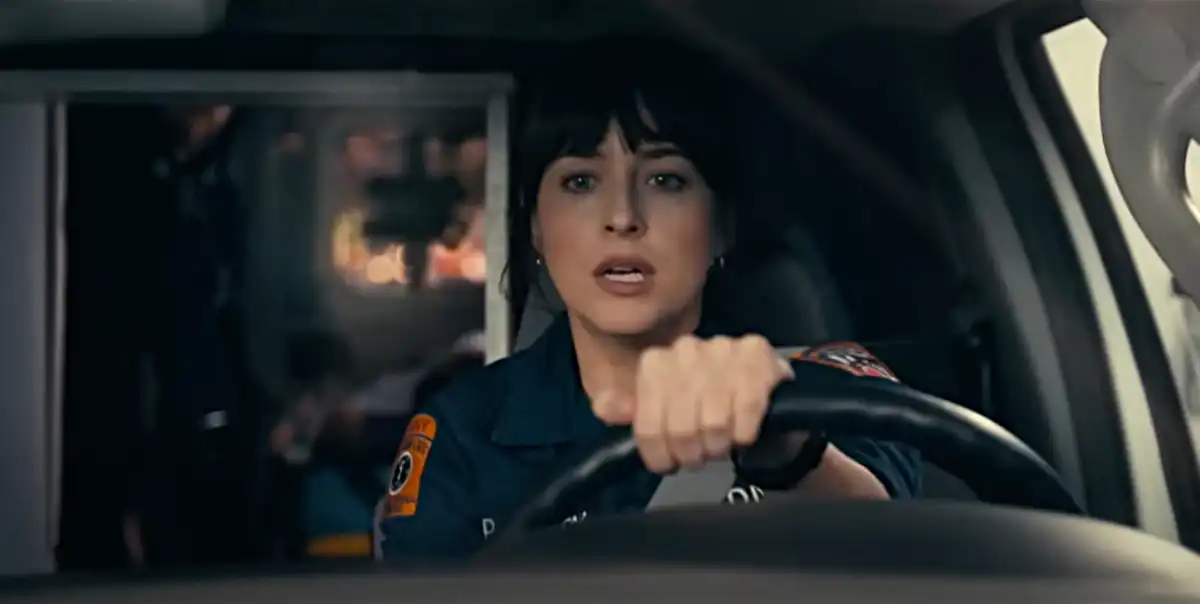 becoming a somehow larger commercial and critical failure. After just four weeks in theaters, Sony Pictures pulled the movie from release. The film was Sony Pictures’ latest attempt to spin-off a new Spider-franchise in Sony’s Spider-Man Universe, but the film’s massive flop canceled those plans, leaving Sony Pictures executives feeling “gloomy.”
becoming a somehow larger commercial and critical failure. After just four weeks in theaters, Sony Pictures pulled the movie from release. The film was Sony Pictures’ latest attempt to spin-off a new Spider-franchise in Sony’s Spider-Man Universe, but the film’s massive flop canceled those plans, leaving Sony Pictures executives feeling “gloomy.”
Returning to familiar ground, Venom: The Last Dance completed Sony Pictures’ Venom trilogy in 2024. It was both a commercial and critical failure, with reviews calling the film “moronic,” “banal,” and “awful.”
Deadline attributed the film’s poor commercial opening to the World Series (because you can’t see a movie and a baseball game in the same day, you just can’t!) and to the old superhero fatigue excuse, even while noting Deadpool and Wolverine was the highest-grossing R-rated film of all time, earning over a billion dollars at the box office. Is it possible Sony Pictures just doesn’t make good superhero films? Venom, Morbius, Madame Web… maybe?! Thankfully, Venom dies at the end of this one, so we’re not going to have to sit through any more of these.
Also released in 2024 was Sony Pictures’ third and final Spidey-related failure of the year, Kraven the Hunter.
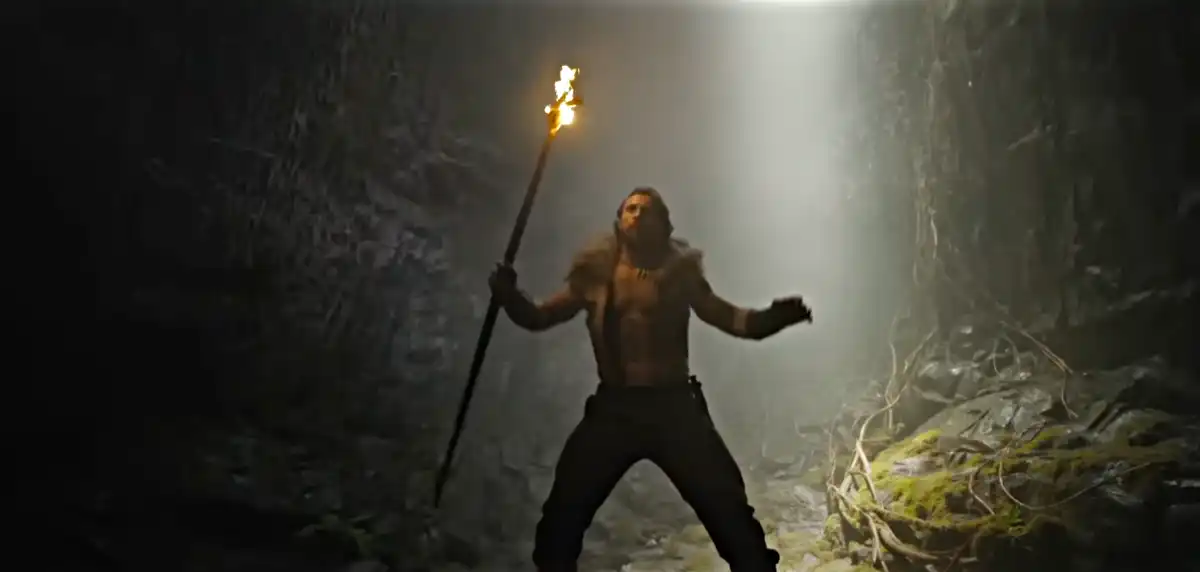 It’s a shame that these villains, like Venom, Carnage, Morbius, and Kraven, who we love in the Marvel comics, are reduced to dumb caricatures in the Sony Pictures films. But Kraven the Hunter could finally mark the end of these movies—the studio is reportedly giving up on Sony’s Spider-Man Universe. Phew!
It’s a shame that these villains, like Venom, Carnage, Morbius, and Kraven, who we love in the Marvel comics, are reduced to dumb caricatures in the Sony Pictures films. But Kraven the Hunter could finally mark the end of these movies—the studio is reportedly giving up on Sony’s Spider-Man Universe. Phew!
Spider-Failures at Sony
There are a few reasons why Sony’s Spider-Man Universe has been failing spectacularly at the box office. The first being: the movies just aren’t good.
But more fundamentally, Sony Pictures’ CEO Tony Vinciquerra, speaking to the LA Times, recently said of Madame Web and Kraven the Hunter, “These are not terrible films. They were just destroyed by the critics in the press, for some reason.”
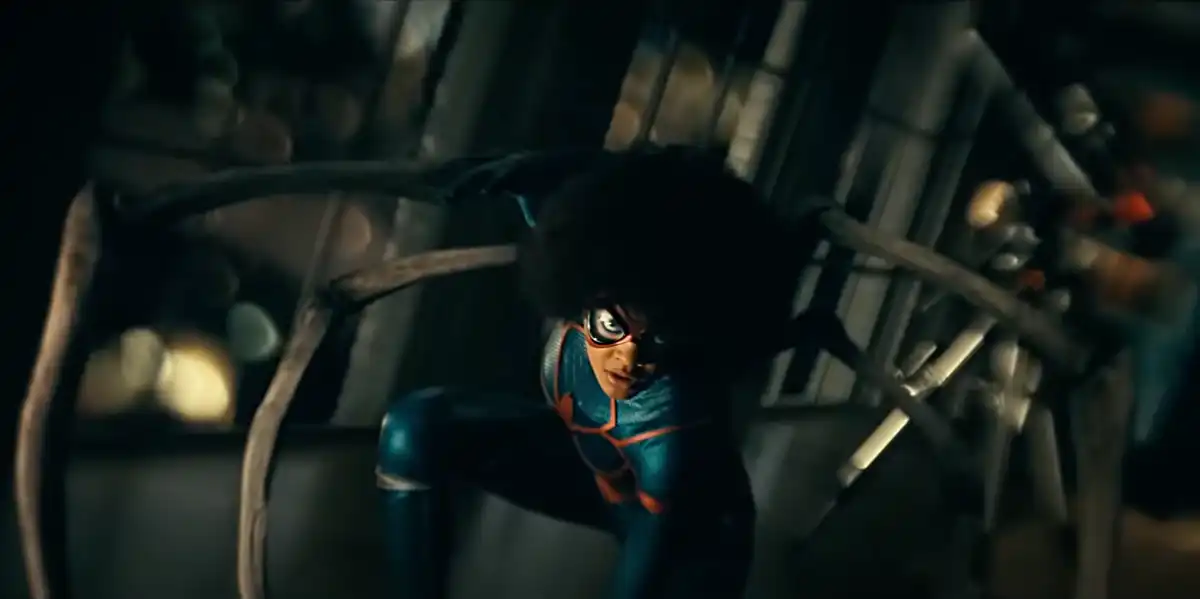 I find a lot of irony in the guy that owns the powerful film rights to Spider-Man not taking responsibility for his bad films and blaming others instead. Critics often give poor reviews to otherwise box office successes, such as Disney’s Moana 2, which broke records over last Thanksgiving, DC Entertainment’s Joker: Folie à Deux, the musical sequel that was badly reviewed but was number one at the box office, Universal‘s Jurassic World Dominion, a mess of a film that grossed over $1 billion worldwide, and even Sony Pictures’ own Uncharted film starring Spider-Man himself Tom Holland, which critics panned but still grossed nearly half a billion dollars at the box office. If anything, I think Sony Pictures’ reputation with Spider-Man films is more to blame for their repeat lack of success, and it’s a bad sign when the movie studio CEO believes the movie critics are out to get him.
I find a lot of irony in the guy that owns the powerful film rights to Spider-Man not taking responsibility for his bad films and blaming others instead. Critics often give poor reviews to otherwise box office successes, such as Disney’s Moana 2, which broke records over last Thanksgiving, DC Entertainment’s Joker: Folie à Deux, the musical sequel that was badly reviewed but was number one at the box office, Universal‘s Jurassic World Dominion, a mess of a film that grossed over $1 billion worldwide, and even Sony Pictures’ own Uncharted film starring Spider-Man himself Tom Holland, which critics panned but still grossed nearly half a billion dollars at the box office. If anything, I think Sony Pictures’ reputation with Spider-Man films is more to blame for their repeat lack of success, and it’s a bad sign when the movie studio CEO believes the movie critics are out to get him.
Another issue with these films is the lack of an enjoyable and relatable protagonist that the audience can root for throughout the film. A good villain often has a personal relationship to our hero, or they’re a mirror into what our hero could be: Doc Ock is Peter’s mentor, while Venom is literally Peter at his absolute worst. Creating these emotional arcs in which Peter/Spidey must confront power without responsibility is a core theme. But when Sony Pictures creates a story of Venom without Spidey, that mirror is lacking, and the themes of power and responsibility are abandoned. Instead, there’s just a CGI blob eating a chicken. The audience gets the joke, but without substance, they don’t come back. That’s not to say that a villain centric story can’t succeed—many have! A villain like the Joker has been re-written and re-imagined dozens of times, providing screenwriters with plenty of source material and the freedom to create something new. Venom, too, has seen a significant evolution throughout the last thirty or so years in the comics, with other characters like Deadpool and Groot getting Venomized. But Kraven and Morbius, outside of the comics, are fairly niche characters, with the added restriction they need to still exist within the bounds of Sony’s Spider-Man Universe. It’s a sandbox with a lot of rules and restrictions—something every kid loves!
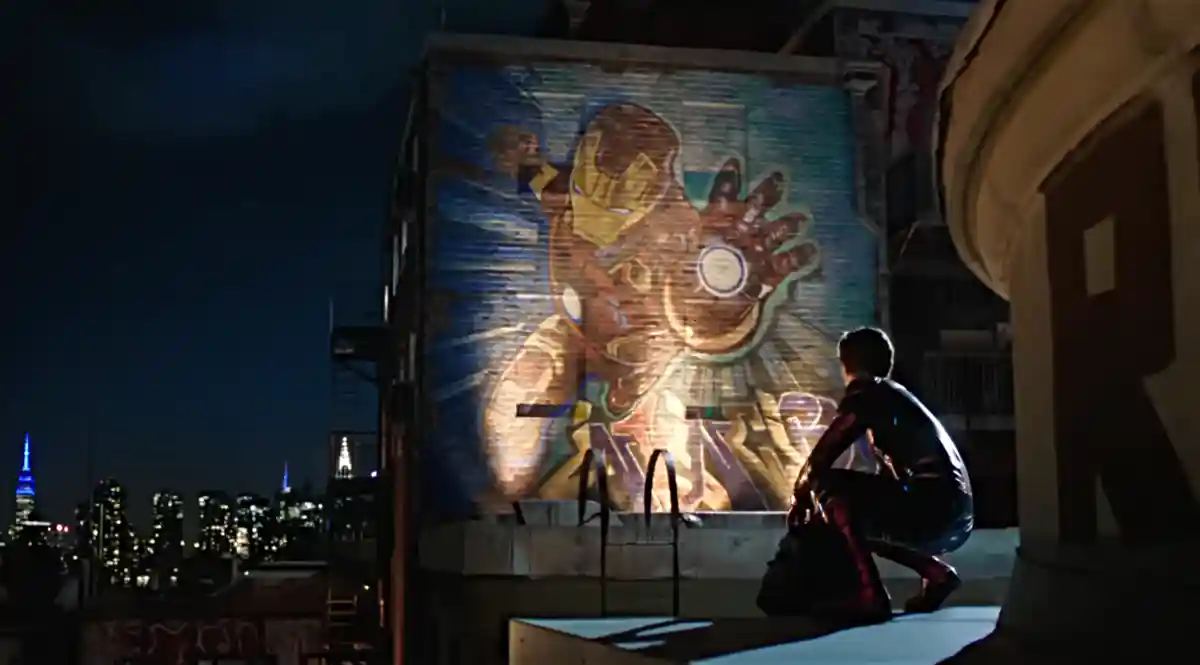
However, the larger underlying issue for Sony’s Spider-Man Universe is a lack of respect for both comic books in general, and the source material specifically. Sony Pictures executives and producers don’t have any emotional or nostalgic connection to these characters—Tony Vinciquerra and Amy Pascal have never read a comic book in their lives. (On the other side of the fence is Kevin Feige, who literally got the job because he knew the source material, and Bob Iger studying the Marvel Encyclopedia before meetings with film executives.)
The Sony Pictures people are not here to tell a good story that will resonate with a passionate, dedicated fanbase, because that requires too much investment for characters with whom they don’t share a legacy. They’re making “desperate,” “uninspired,” “forgettable,” and “cringy” films in an attempt to lure comic book fans to the theater for a quick buck. Sony Pictures holds the rights to one of the most valuable comic book properties in the world—and yet, for the past twenty years, their greatest achievement has been loaning the character back to Disney for half a dozen films. As The Ringer astutely notes, “it feels like these films were made out of a sense of obligation, rather than any sincere artistic intent.” And that’s true: Sony’s Spidey-contract requires a new Spider-Man film “every five years and nine months,” otherwise the rights revert to Marvel. While the studio hasn’t technically lost money on any of their Spider-Man Universe films since 2002, a movie should be more than its sum total of box office revenue. Sony Pictures and Amy Pascal have not shown the respect and appreciation deserving of fans or theater audiences—she called Stan Lee “not the least bit coherent,” which ought to be enough to invalid their claims to the film rights—and have been poor stewards of these iconic characters. Sony is too focused on chasing box office revenue to invest the time and effort to tell a story true to these characters’ rich comic book history.
Now that he’s joined the MCU, one could argue that Spider-Man has been released from his imprisonment, but I would contend that Spidey is still tightly bound by Sony Pictures—
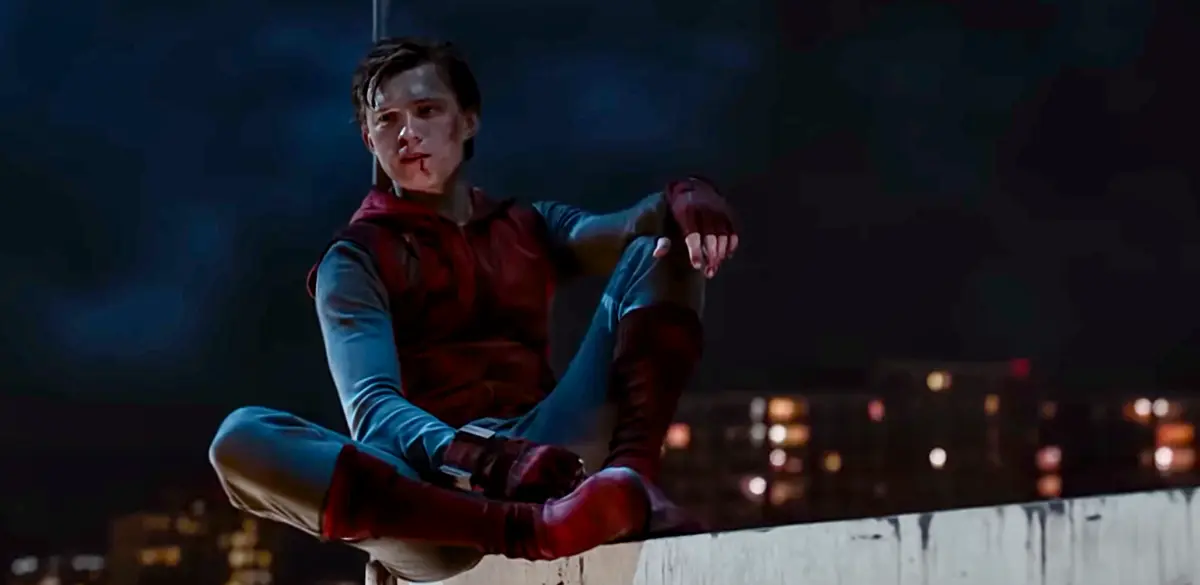 we've already seen how easily deals between Disney and Sony can unravel. Will Spidey ever return home to Marvel Studios? Probably! If anything, Hollywood is like a spider’s web: delicate and intricate, weaving together countless threads of talent, but just as the spider re-spins her web, the industry changes with new deals and trends. The web may seem beautiful and resilient, but its fragility can unravel years of effort with the slightest change of the wind…
we've already seen how easily deals between Disney and Sony can unravel. Will Spidey ever return home to Marvel Studios? Probably! If anything, Hollywood is like a spider’s web: delicate and intricate, weaving together countless threads of talent, but just as the spider re-spins her web, the industry changes with new deals and trends. The web may seem beautiful and resilient, but its fragility can unravel years of effort with the slightest change of the wind…
The Spider-Verse

When I said Sony Pictures has squandered their investment in Spider-Man, there is one notable exception to this, and it’s an Academy Award-winning exception: Spider-Man: Into the Spider-Verse. This cinematic masterpiece of art and animation won the Academy Award for Best Animated Feature and was praised by critics, holding a 97% approval rating on Rotten Tomatoes and 4.4 stars on Letterboxd.
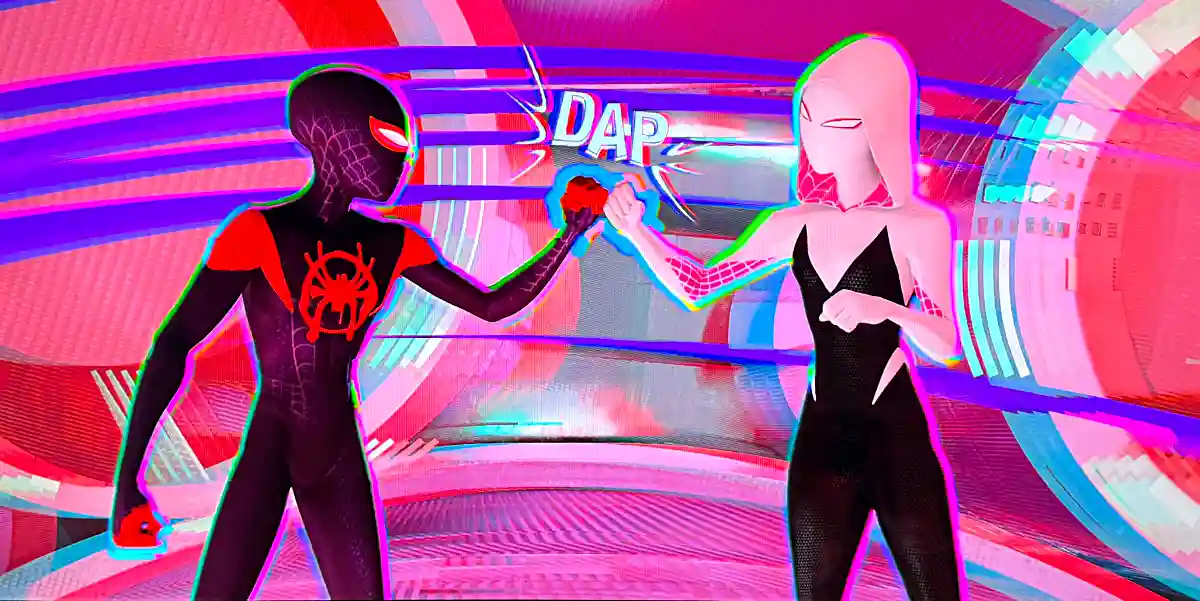 Into the Spider-Verse finally brings Miles Morales (Shameik Moore) to the Big Screen, telling a Spider-Man story with real heart, humor, and stunning animation. Swinging along with Miles is Peter B. Parker/Spider-Man (Jake Johnson), a kind of washed-up, slightly out of shape Spider-Man who recently went through a breakup with girlfriend Mary Jane Watson. Gwen Stacy, aka Spider-Woman (or as we know her, Spider-Gwen) (Hailee Steinfeld), Spider-Man Noir (Nicolas Cage), the anime-inspired Peni Parker (Kimiko Glenn) with her SP//dr mech, and Peter Porker/Spider-Ham (John Mulaney) join Miles as he fights the Kingpin (Liev Schreiber) and Doctor Olivia “Liv” Octavius (Kathryn Hahn), saving the world from a collapse/explosion of the (animated) multiverse.
Into the Spider-Verse finally brings Miles Morales (Shameik Moore) to the Big Screen, telling a Spider-Man story with real heart, humor, and stunning animation. Swinging along with Miles is Peter B. Parker/Spider-Man (Jake Johnson), a kind of washed-up, slightly out of shape Spider-Man who recently went through a breakup with girlfriend Mary Jane Watson. Gwen Stacy, aka Spider-Woman (or as we know her, Spider-Gwen) (Hailee Steinfeld), Spider-Man Noir (Nicolas Cage), the anime-inspired Peni Parker (Kimiko Glenn) with her SP//dr mech, and Peter Porker/Spider-Ham (John Mulaney) join Miles as he fights the Kingpin (Liev Schreiber) and Doctor Olivia “Liv” Octavius (Kathryn Hahn), saving the world from a collapse/explosion of the (animated) multiverse.
Written by Phil Lord and Rodney Rothman, and produced by Lord and Christopher Miller (the duo behind The LEGO Movie), Into the Spider-Verse‘s art and animation were inspired by Miles Morales co-creator Sara Pichelli’s comic book artwork. According to Lord and Miller, they wanted the audience to feel like they had “walked inside a comic book,” and the film frequently shows brief flashes of comic book sound effects, like THWIP, and the vintage comic book “Ben-Day dots” art style. It’s a visual design that took a year to create and has inspired the visual effects for the live-action MCU series Ms. Marvel and the animated Moon Girl and Devil Dinosaur series, among others.
James Gunn, writer and director of the MCU's Guardians of the Galaxy trilogy, called it his “favorite superhero movie,“ Kevin Feige said he “loved it,“ and Tom Holland called it “the best Spider-Man movie that’s ever been made.” And I couldn’t agree more.
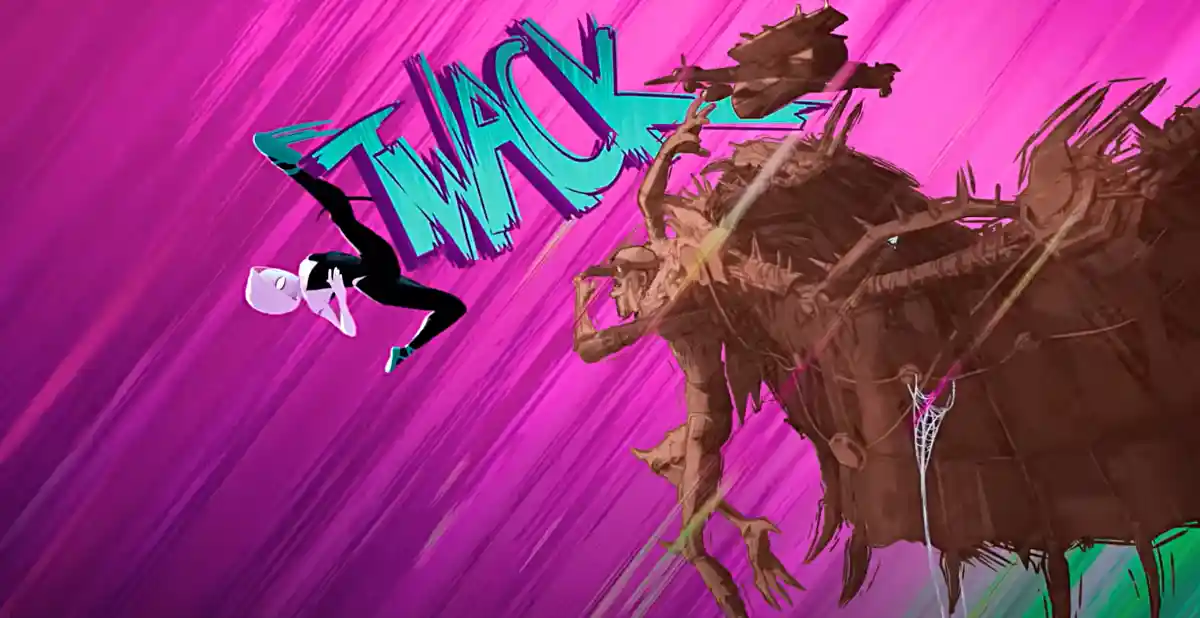
Slightly delayed due to the pandemic, 2023’s Spider-Man: Across the Spider-Verse picks up shortly after the first film, as Miles is pulled once again into the Spider-Verse where he joins the Spider Society, a team of Spider-People protecting the multiverse. There are so many Spider-Characters in this film that I can’t Spider-List them all, but Spider-Man India, Spider-Punk, Jess Drew aka Spider-Woman, and Spider-Man 2099 are all major new characters, with Peter B. Parker and Gwen Stacy/Spider-Woman returning from the previous film. The film ends on a climactic cliffhanger, but the third and final film in the Spider-Verse trilogy, Spider-Man: Beyond the Spider-Verse has been delayed, possibly until 2027…
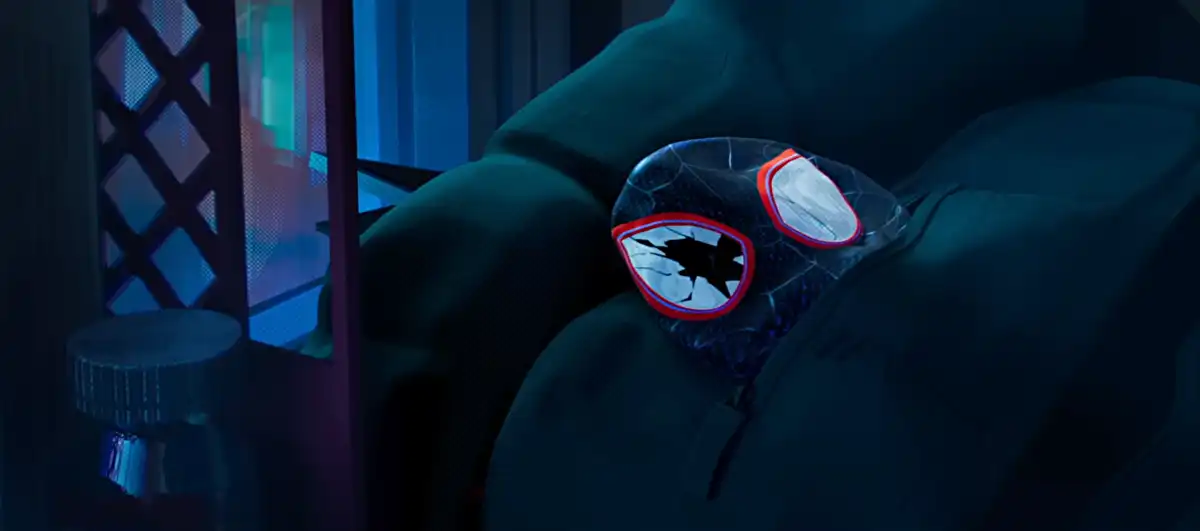
Sony Pictures also released The Spider Within: A Spider-Verse Story, a short film set between the events of Into the Spider-Verse and Across the Spider-Verse. The short was released on YouTube in 2024 in support of the Kevin Love Fund, an organization supporting mental and physical health. The Spider Within tells the story of Miles as he “experiences a panic attack that forces him to confront the manifestations of his anxiety and learn that reaching out for help can be just as brave an act as protecting his city from evil.”
Additionally, a Spider-Women spin-off with Gwen Stacy, Jessica Drew, and Cindy Moon (Silk) has been in development for several years—keep your Spider-fingers crossed for this one!
Fun and Games
Marvel Animation’s Your Friendly Neighborhood Spider-Man swung onto Disney+ on January 29, 2025. The series follows Peter Parker (Hudson Thames)
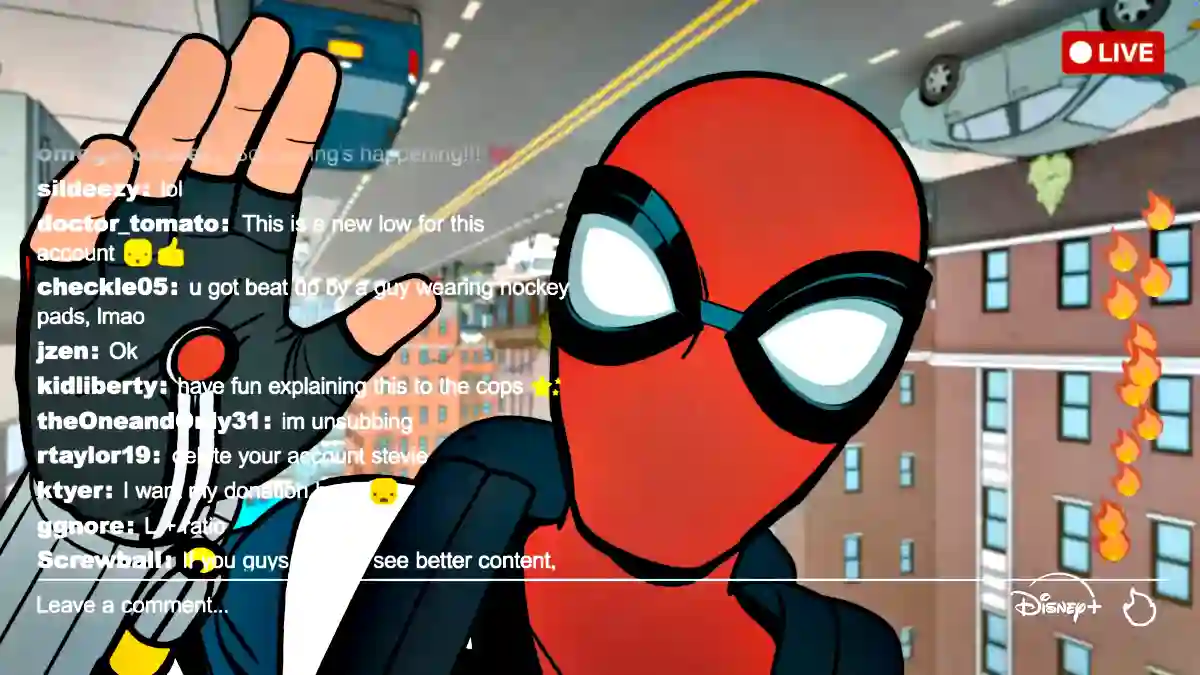 as he spins his first webs as a superhero with Norman Osborn (Colman Domingo) taking on the role of mentor. Originally announced as Spider-Man: Freshman Year in 2021, it was meant to serve as a prequel to the Homecoming trilogy, but with only six months from spider bite to Avengers battle, the sandbox was too restrictive, so it’s now an alternate universe story. The 3D cel-shaded animation embraces the retro style of Spidey co-creator Steve Ditko and John Romita Sr., and within minutes I was fully webbed up in its throwback charm.
as he spins his first webs as a superhero with Norman Osborn (Colman Domingo) taking on the role of mentor. Originally announced as Spider-Man: Freshman Year in 2021, it was meant to serve as a prequel to the Homecoming trilogy, but with only six months from spider bite to Avengers battle, the sandbox was too restrictive, so it’s now an alternate universe story. The 3D cel-shaded animation embraces the retro style of Spidey co-creator Steve Ditko and John Romita Sr., and within minutes I was fully webbed up in its throwback charm.
Also in Marvel's What If… animated series, there’s a multiverse Zombie Hunter Spider-Man variant (also voiced by Thames).
And, while also not technically cinema, Marvel’s Spider-Man video game series, developed by Insomniac Games, lets players swing through New York City as Peter (Yuri Lowenthal) or Miles (Nadji Jeter)
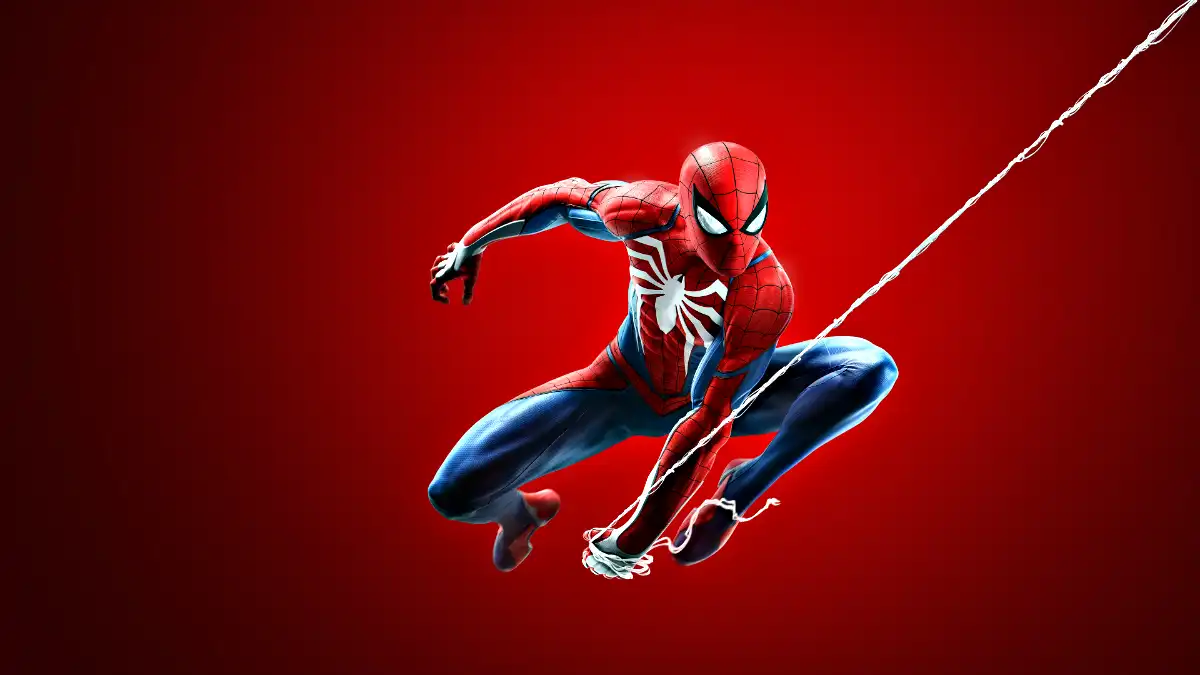 while battling Doc Ock, the Lizard, and Venom. The gameplay, animation, and voice acting are some of the best you’ll see on modern video game consoles. To describe it as anything less than cinematic is doing the games a massive disservice. Swinging through the city as Spider-Man is a relaxing, almost meditative experience—it’s also really fun beating up the bad guys.
while battling Doc Ock, the Lizard, and Venom. The gameplay, animation, and voice acting are some of the best you’ll see on modern video game consoles. To describe it as anything less than cinematic is doing the games a massive disservice. Swinging through the city as Spider-Man is a relaxing, almost meditative experience—it’s also really fun beating up the bad guys.
In 2021, Avengers Campus opened at Disney’s California Adventure in Anaheim, California. Part of the new theme park land is Web Slingers: A Spider-Man Adventure, which takes guests into Peter Parker’s Worldwide Engineering Brigade. Tom Holland reprises his role as Peter Parker/Spider-Man, who has enlisted guests to test out his new WEB Slinger vehicles. But when his robotic helper Spider-Bots begin to malfunction, guests must sling webs (using the classic two-fingers on the palm gesture) in this 3D interactive ride to capture all the Spider-Bots and save WEB. Web Slingers is part ride and part scripted interactive story, and there’s a fun live-action Spider-Man show that takes place on the roof of the building throughout the day with a very fancy animatronic stunt robot that swings and flips through the air in the classic Spider-Man poses.
Thanks For Reading

Twenty-three years ago Spider-Man swung into movie theaters worldwide for the first time. Peter Parker is a geeky, awkward kid with a wholesomeness that many of us can relate to—and why his comics, films, cartoons, video games, and theme park rides have made Spider-Man one of the most popular characters in today’s pop culture.
As a child, I grew up watching the Spider-Man cartoons (and, full disclosure, the Super Friends). As a kid I collected and traded the old Marvel Trading Cards from the ’90s, meeting some of my favorite heroes for the first time on little slips of cardboard between middle-school classes. As a teenager and twenty-something I began venturing into the comic book aisles to discover the works of Todd McFarlane, J. Michael Straczynski & John Romita Jr., and Brian Michael Bendis & Sara Pichelli. And now, as an adult, Spider-Man collectables and artwork decorate my home. While I don't have as much time to read the comics these days, I try to keep up on Peter, Miles, Gwen, and all the Spidey-friends—I even got to meet Spider-Man once at Disney’s California Adventure. The Spider-Man films have introduced movie-goers around the world to my favorite superhero, and to me they represent the purest realization of why I love the character. Films are my favorite storytelling medium, and seeing Spider-Man swing across the screen is nothing less than spectacular, every time.
Despite being Marvel’s only remaining intellectual property to have not yet returned home, Disney and Sony Pictures have maintained an awkward and
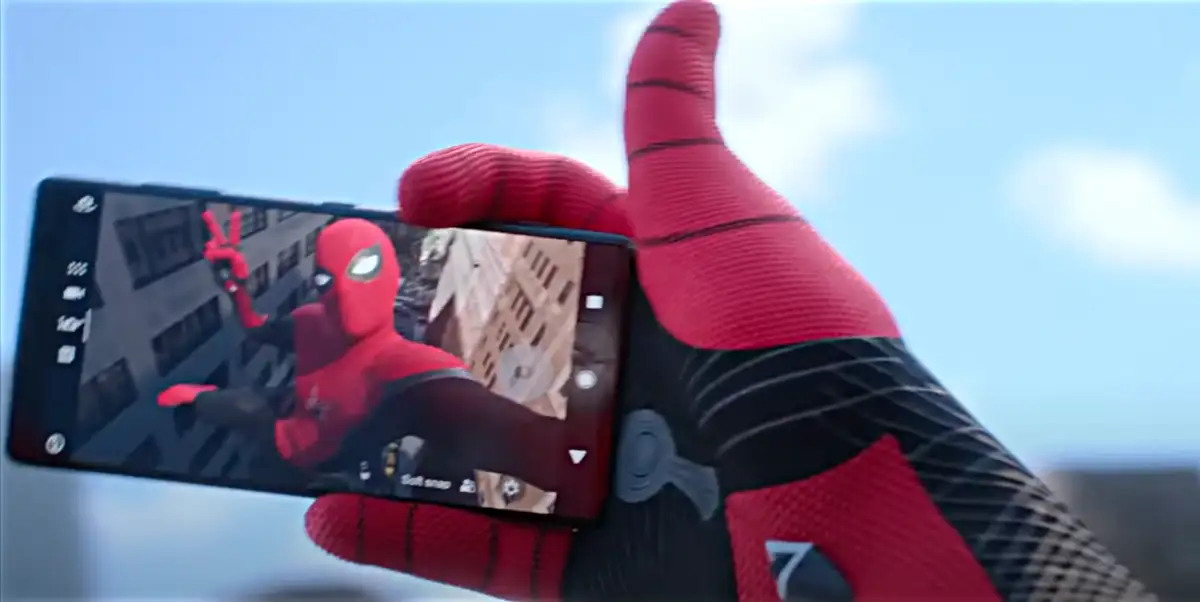 sometimes difficult collaboration producing Spider-Man films—the results of which are some of the most critically and commercially successful films in the history of cinema. I hope these dueling film studios can maintain—and strengthen—their partnership to continue telling amazing stories about our friendly neighborhood Spider-Man.
sometimes difficult collaboration producing Spider-Man films—the results of which are some of the most critically and commercially successful films in the history of cinema. I hope these dueling film studios can maintain—and strengthen—their partnership to continue telling amazing stories about our friendly neighborhood Spider-Man. 
“With great power comes great responsibility…”
